|
 |
Showing posts tagged as "ForgottenGames"
|
This blog entry marks the first in a series discussing forgotten RPGs. When I write forgotten, I mean games that most people never heard of or that didn't last long on store shelves for one reason or another. This batch consists of fantasy games. These games have been sitting on my shelf for years, mostly ebay finds to add to my collection.


1. Dawnfire (by Jason Marin; published by Dawnfire Games / Committed Comics in 2000)

This game is unique, as I can't remember seeing another share its one odd characteristic, that of being printed on what feels like newsprint. You know, that really thin newspaper paper. It's got 12 core races, including winged humanoids and 3 types of Elves. Then are are 6 types of optional races, including a second type of minotaur and dwarf, another elf, and shape changers. Statistics consist of 3 physical (strength, agility, and endurance), 3 mental (IQ, common sense, and perception), and 3 social (presence, manipulation, and luck). Then there is a focus: either warrior, rogue, or shaper (magic-user). A basic skill roll is made with a d20. Rolling under the skill level (+ statistic modifier) is a success. Combat is similar, rolling under a base of 10 (+modifiers). The book deals with skills, magic, monsters, skill lists, and experience. Some of the art is really good, but most is either OK or weak. While the system seems fairly simple, I'm put off by all the modifiers for statistics and skills (sort of like attribute modifiers for D&D). Not a bad attempt for the 80s, but I would expect more from a 2000 release.

EDIT: Two other games used newsprint: the original Mechanoid Invasion by Palladium Games and DC Heroes by West End Games.

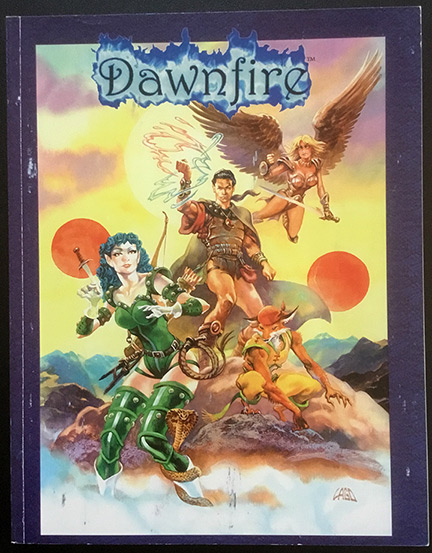


2. GateWar (by Ken Burridge; published by Escape Ventures in 1994)

This is the third edition of what was originally called Element Masters. I don't have that book, but I've seen it appear on eBay numerous times. The layout is crisp and easy to read. The game takes place on the world of Vinya. While it is a fantasy game in principle, alien races are present due to the opening of a gateway between worlds. There are 7 races, with some mimicking traditional fantasy races. Lots of charts in this game for determining random elements. There are 8 characteristics: strength, size, constitution, dexterity, intelligence, magic point total, appearance, and luck. There are secondary characteristics derived from the main ones. Other factors like materialism, interests, handedness, and mental quirks also help define characters. There are lots of professions that may provide some benefits, but also determine a daily wage. Tasks are performed with percentage rolls based on a character's skill. Raw feats of ability (using only a characteristic) are done by assigning a difficulty, determining the difference between the difficulty and character's score, and adjusting a base 50% chance by ±5% x difference (sort of like Man, Myth & Magic in this regard). Did I mention that there are lots of tables? Lots of tables with lists of numbers. There are some interesting rules for combat like blood loss, but attack rolls seem to rely on combat skills -- it's rather confusing. The creatures section is massive and some of them are really interesting. I can see borrowing these for other games you may be running. In fact, the setting could easily be integrated with Exiled in Eris. I'm not sure what to think of this game. I actually like it, but I would revert to another system for ease of use.




3. Of Gods and Men (by Jeffrey Konkol; published by Non Sequitur Productions in 1991)

Since the character sheet appears on the third page, I'm going to start with that. There are 6 primary abilities: strength, dexterity, health, influence, knowledge, and will. No luck this time. Secondary values include body points, dodge points, energy, power, movement, and encumbrance. Rather than having various races as in most other fantasy games, this one focuses on (human) cultures. And each one has a different skill list with different calculated values. Combat seems a bit odd to me: percentage chance to hit is skill level ± modifiers - protection, but 86+ automatically misses -- then the defender can also choose to parry at his skill level. Everything else in the game seems pretty well fleshed out, and there are some interesting creatures. 54 divine power cards are inserted in the book to be separated and given to players when the GM thinks it appropriate -- this is a unique feature, but can be easily done with a chart. Not a bad game, but it is somewhat confusing to me. Still, nowhere near as many charts and tables as in GateWar.

EDIT: It seems that this game is still around in PDF format (Link).

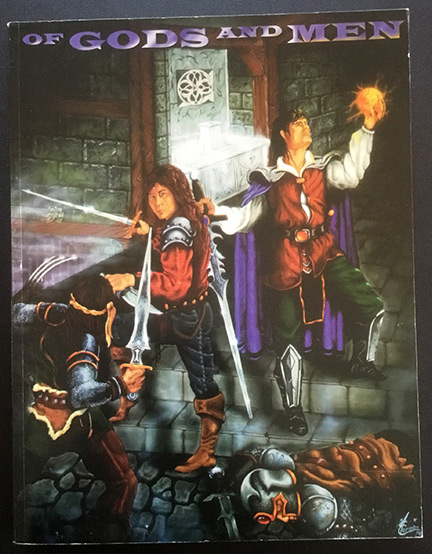


4. Quest of the Ancients (by Vince Garcia; published by Unicorn Game Publications in 1988?)

The first thing I see upon opening the book is a transparency with something called the spell circle, which is used to determine the area of effect when using miniatures. Not what I would expect to find in this book, but let's see what else there is (it's been a while since I've opened this book). The layout has an Amber RPG feel to it. There's a page with a bunch of tables before chapter one, containing info about race stat modifiers, modifiers for certain magical rolls involving monsters, how to determine armor rating based on materials and agility, and stat adjustments for amor, damage, skills, and attack. There are 9 stats: strength, agility, conditioning, IQ, charm, appearance, luck, stamina, and body (average of strength and conditioning). There are lots of tables for the stats akin to D&D. The typical races are present, with various professions in place of classes, even though they use levels that are gained with level points, and unlock special abilities and bonuses. There are multiple types of fighters: cossack, gladiator, knight, legionnaire, rogue, saracen, viking, and woodsman. Same with tricksters: assassin, bard, cutpurse, and gypsy. Then spellcasters: druid, earth priest, necromancer, sorcerer, and witch. All the relevant spells are listed with each profession, so we're up to page 157 out of 216. Skills are on pages 158-160, telling me that you get IQx10 points to buy skill percentages, but not all are at a 1:1 ratio. Then equipment. Then a few pages for adventure concepts. Finally, combat on page 173. Anyone have a d30 to roll? Base to hit is 22 or less at AR 5(+2), plus modifiers. Easy enough, but the part explaining how to modify the roll based on armor rating is very confusing. I gave up worrying about it after 10 minutes. I turned the page to find a bunch of long tables that tell me to forget those armor calculations as I can just look them up (sort of like D&D to-hit tables, but longerrr (3 double-column pages). Pages 182-186 tell us how to use all those handy spells. We've got some rewards (treasures) and then a basic map and a bunch of monsters. I probably could have cut this down to half the size. Seriously, other than hardcore old-school and DCC gamers, does anyone have a d30?

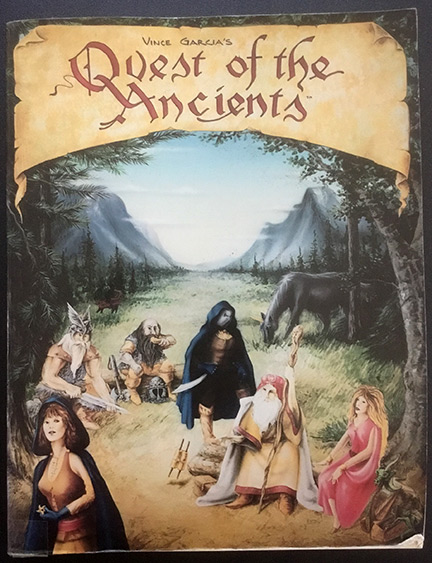


4. Shades of Heroes (by Jason "Kurbs" Kirby; published by Argonaut Game Studios in 1998)

First impression: the layout is reminiscent of stuff I've seen within the last 10 years. Not a good or a bad thing, just how I picture it. We've got the three basic in fantasy races (humans, dwarves, and elves) plus Ferlings (short, furry things), Obdrons (tall, muscular, and mostly hairless), and Wolcs (shape-shifters). There are 6 attributes that range from -5 to 10: strength, agility, fortitude, intelligence, perception, and charisma. That's a pretty solid and efficient spread. There are some derived attributes, of course: life points, hit points, initiative, speed, action points, mana, hit rating, defense, damage bonus, and carry. We get a bunch of skills too. The weapon and armor art is my favorite art in the book. I thought the attribute rating may have a direct effect on rolls, but I was wrong. They merely determine those derived attributes and then tell you what sort of die combination to roll. For example a rating of 2 is 1d10, while a rating of 10 is 1d20 + 1d6. Looks like I'm wrong. You actually roll dice determined by the difficulty (hard or 7 is 1d10+1d3), rolling over the relevant attribute score. Perhaps the attribute dice are for opposing rolls. Turns out the derived hit rating is used to determine what dice combination to roll for attack. Huh! Spells, treasure, and the usual assortment of monsters finish the book.

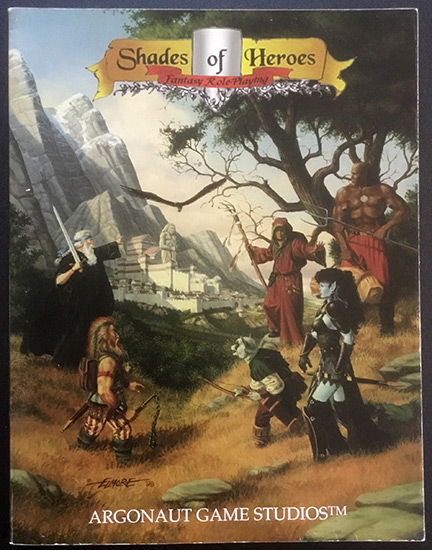


5. The Essential Fantasy Earth (by Michael C. Zody; published by Zody Games in 1996)

Set in Helvetica. Let's see what this is about. It says to assign certain values to 10 different abilities: strength, endurance, agility, speed, manipulation, perception, intelligence, mental strength, power, and charisma. That's a lot for a game with skills. There are 4 classes: warriors, burglars, rangers, and sorcerers (each with its own skill list). Fooled again. I thought this 1-10 scale might have a direct correlation to rolls. Nope. Modifiers. So, we roll 1d10 + skill level ± ability modifier (-4 to +4) to beat a difficulty number (similar scale as modern D&D). Easy. Combat is different. Roll 2d10 + same as before + weapon modifiers - injury penalties, etc. against a difficulty of 16 for melee. Ranged combat determines the modifiers differently by doubling some of them -- and difficulty depends on range. I don't know. I gave up again. Then the defender can parry vs. difficulty of 18. Did I miss something again? Why 2d10 instead of 1d10? Spells and basic setting round out the rest of the book, as it's meant to be a basic guide (this is like the basic version). It's got the makings of a new millennium game, but doesn't quite get over the hurdle by being trapped in inconsistencies (I get a sense of a MasterBook-like approach at times). This is the shortest of the group, at only 78 pages.




That's it for now. If I had to recommend one, it would probably be GateWar to mine for ideas.


Part 2... | | 4 Comments | Add Comment | Permanent Link | See All Posts Tagged as "ForgottenGames" | | Read more... | |
This is part 2 in a series discussing forgotten RPGs (Part 1 can be found here). That is, games most people have never heard of or that didn't last long on store shelves for one reason or another. This batch consists of science fiction games. These games have been sitting on my shelf for years, mostly ebay finds to add to my collection.


1. Space Infantry (by Daniel Douglass Hutto; published by D&R Game Design in 1982)

From what I can tell, there were multiple add-ons for this game, but I only have the original rules book. This is a small, 70-page digest-sized book utilized 6 and 10-sided dice. There is no setting, just the rules. Characters consist of 6 qualities, ranging from 1-20 (though most start at 1-10): intelligence, agility, speed, strength, constitution, and charm. The odd thing is that the book says that charm is not very important for game purposes, but players are always concerned with their characters' looks. That's fine, but at least try to work it in the game somehow. So level increases are basically increases in rank, which provide new benefits. Characters start as cadets. The typical space combat skills are included, but it looks like each character only gets one, which becomes his specialty. Combat is handled by rolling a cross-referenced percentage from both opponents' agility rating. Other factors, like injury, can alter this percentage. Other maneuvers can be performed at a percentage determined on charts by the character's agility or strength ratings. Ship combat is more involved, but similar in design. There's basic rules for creating aliens (which are handled like other games' monsters). There's not much art, but the ship designs are pretty good. All in all, a very good game for its time and the original price ($8), but lacking in the content of other contemporary games like Star Frontiers.




2. Strange Frontiers (by Mark D. Hansen; published by New World Games in 1999)

First off, the cover does not exactly tell me what this game is about. Lots of anthropomorphic figures. The introduction says that this is a game of fantasy and science fiction with the feel of the old west. They lived up to the name when it comes to the art. There's some odd races, which are the ones on the cover. Characters get 11 inherent attributes rated at 4d6 plus modifiers: brawn, toughness, grit, speed, steady, awareness, smarts, sense, influence, luck, and power. There are several professions, limited by race, that provide skills. So when you get a skill, you roll either 1d4 (non-professional skills) or 1d8 (professional skills) and add the result to the computed formula for the skill. There are also derived attributes, but I kind of got bored at this point. Attribute checks are made by referencing the Save Table with the rating and check's difficulty to find the number that must be rolled under with a d20. I think combat works in a similar manner, but the explanations are very hard to follow. There is a fantastic D% hit location diagram -- it's a tad overkill. About 3 pages of bizarre-looking weapons -- at least that fits the concept. Lots of weapons. There's also Magik. I just didn't feel like reading it. Maybe it's interesting, maybe not. Finally, there's a few pages on the planets and other celestial bodies. I'm not even sure how to describe this game or if I can make any further comments. It just is. Nothing makes me want to play it.

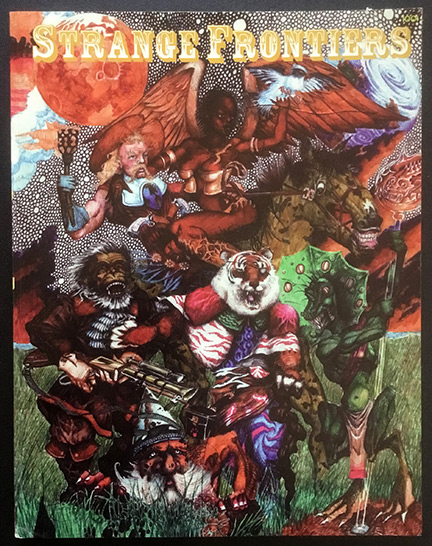


3. Expendables (by L. Lee Cerny; published by Stellar Games in 1987/1990)

This game has an interesting premise. You work for the company. They train you, sell you a lander and equipment, and provide interstellar transport to and from a planet to prove for colonization. Characters have 6 basic abilities rated 4d10: strength, dexterity, brains, charisma, fitness, and luck; plus survival points (calculated) and psionics (depending on luck). Skill ratings are equal to the related ability +1d10 (other modifiers may also apply). They are used by making a D% roll, with the difficulty adjusting the roll by 10-30% as needed. If a skill rating is 20+, the character is considered competent enough for routine tasks for no roll to be needed. Combat works the same, making a roll for the necessary skill (competence does not apply). There's lots of weapons, vehicles, and spacecraft. Then there's several pages on the setting, followed by a number of optional rules. GM info and planet generation comes next. A solid, easy to learn RPG in the Stellar Games tradition. I like just about all the stellar Games RPGs. If possible, I would pursue purchasing the rights to their entire catalog, but its seems to be tied up in limbo.

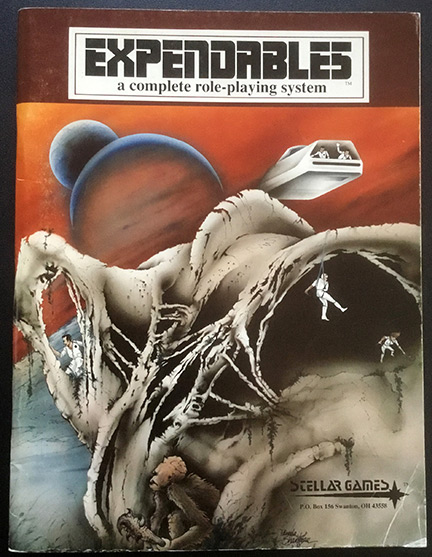


4. Journeyman (by Frederick Goff; published by Infinity Games in 1989)

The layout on this one kind of reminds me of Palladium's books. We start off with some background (always a good start). Characters have 7 characteristics rated at 3d6: strength, intelligence, will power (yes, two words), dexterity, constitution, endurance, and charisma (pretty close to D&D for those who don't like to stray). A number of professions determine starting skills and their random levels. For species, we have Human sub-races (heavy worlders, light worlders, and eugenics), Sekan (amphibians), Kumoli (they sort of look like walking hippos), Detchal (kind of like skeletal reptilians), Methreen (insectoids), Gamoi (bear-like centaurs?), and Skelkis (slug-like). As far as aliens go, these are different. Skill contests are handled by comparing 1d10+skill level+modifiers. Regular skill use is rolled the same way, but must beat a 10. Characteristics seem to only apply for saving throws, which are 1d20 less than rating. Combat rolls are merely skill contests. There's info on robots, cybernetics, bioconstructs, and world generation (some pretty lengthy tables for things like gravity and density). Page 100 brings us spacecraft. It's pretty extensive, including construction, leasing, and combat. Appendix III provides metric conversions and equations involving square roots, exponents, and even integrals. I like the commitment to explain certain elements in the game, but I'm glad this made it to the appendix and not the rules themselves. I can see porting the alien species to other games, but the system does not do it for me. Not a whole lot of art, but I'm glad they provided it for the aliens.

EDIT: I just downloaded a game called Stellar Wind by chance, which is apparently a rebranded version of Journeyman by Higher Dimension Games (there seems to be a few editions and you can get the original too).

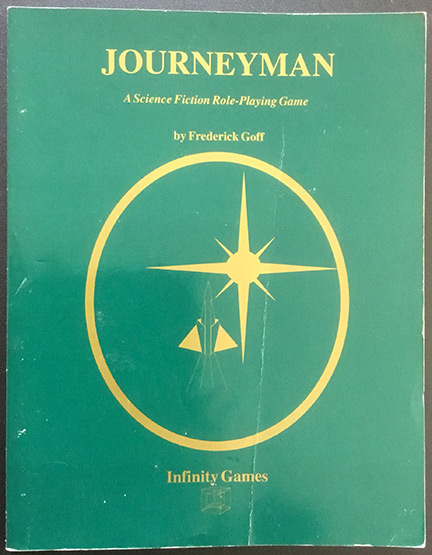


5. Cooperation (by Charles J. Walther; self-published in 1997)

Straight to characters. Seems like a no-nonsense approach. Character get 9 independent traits: strength, dexterity, endurance, intelligence, appearance, will power (another two-worder), luck, perception, and insight. They seem to be on a % scale, but points are allocated to be above a minimum rating to a maximum of the racial average+30. There are also dependent traits which are calculated: health, response, and personality. Skill levels are percentage-based, so you roll under with modifiers applied for difficulty level. Combat is the same. Traits don't seem to directly interact with rolls, except that they may provide modifiers or help increase skill levels. All the trait modifiers are actually very confusing. There's ship construction and combat rules, but I wasn't really interested in checking them out at this point. Page 61 introduces the history of mankind and the cooperation (a federation of races). This is followed by a section on alien races, even though you need to pick one for character creation (and they are not mentioned there); these are: Mantu (insectoids), D'Thal (kangaroo-like), Wom (blobs with appendages), Crys (crystalloids), Flots (crabs), and Yadeze (unplayable brutes). More info on governments, laws, planets, and economics. The five triple-columned reference pages illustrate the complexity of the system perfectly. I can easily see adapting the setting to another system, whether as a stand-alone setting or something to hybridize with another. Art is sparse and nothing inspiring.




6. High Colonies (by Eric Hotz and Edwin King; published by Waterford Publishing House Ltd in 1988)

This feels like a Stellar Games product, but it's not. We start with a timeline of events from 1990 to 2188, and then there is a catalog of worlds and organizations. We're up to page 49. That's a lot of background so far. Characters can either be Human or an alien species called Chakon, and use five basic attributes (rated as 2d6+[4, 9, or 10]): strength, constitution, intelligence, dexterity, and charisma (we're just missing wisdom). You get a number of skill pints to divvy up (attributes+age x6), to a maximum of 95 per skill (some already have a default value). Skill checks are basic D% rolls. Combat is different. A number of D6 are rolled depending on the weapon action, and -10 to +10 modifier derived from a combat skill is added to the result, as are other modifiers (±dice or ±numbers). Once again, it looks like attributes just add modifiers rather than have a direct effect. Then subtract the defender's total from that of the attacker and halve the result. This value is then limited by the rounds fired by the weapon to determine the number of hits. Sounds a little like Tunnels & Trolls. There's relatively simple space combat rules, as well as info on a few alien species, bio-gens, and bots. A few scenarios are also included. I reiterate that it feels like a Stellar Games product, although the system is a bit more complex. I hear that a new edition is in the works. Might be worth checking out. I think the system would be easy to run with a better explanation.

Update: This seems to have been revived by Columbia Games.




That does it for this batch. Let me know what genre you'd like to see next. I'll eventually swing back around to fantasy for the glut that it is.


Part 3... | | 6 Comments | Add Comment | Permanent Link | See All Posts Tagged as "ForgottenGames" | | Read more... | |
This is part 3 in a series discussing forgotten RPGs (Part 1 can be found here and Part 2 here). That is, games most people have never heard of or that didn't last long on store shelves for one reason or another. This batch consists of supernatural games. These games have been sitting on my shelf for years, mostly ebay finds to add to my collection.


1. Stalking the Night Fantastic (by Richard Tucholka; published by Tri Tac Inc. in 1983)

You are a government agent charged with taking out supernatural threats in this game. Characters consist of about 17 statistics. I say about, because some are computed and others are rolled as 4d6-4. The rolled ones are strength, constitution, dexterity, agility, intelligence, wisdom, luck, charisma, accuracy, sensitivity, and magic resistance (1d6). Others include psionics, throw, dodge, hit points, magic, and piety. Then there are skills... lots of skills, each rated from 0 to 20. Tasks are performed as percentage rolls, with the difficulty (1-13) determining the base percentage (+95% to -95%), and an appropriate skill adding 5% per level. An interesting rule allows for random difficulties. For example, how hard is it to perform an easy acrobatic stunt? Roll a d4 to determine its difficulty. That sounds rather unique, although Two-Fisted Tales does include random target numbers, but mostly for automatic success/failure. So what happens next? Adventures consist of fighting the bad guys, which are typically monsters like vampires, ghosts, and mortal threats. There are special rules for different types of damage, like blades, burns, infections, and atmospheric pressure. There's psi powers, magic, priestly powers. All in all, this probably set the standard of the time for completeness. The only thing missing is a sample adventure. This would have had two direct competitors: Call of Cthulhu and Chill. The former doesn't really have common supernatural creatures, so Chill would have remained my pick back in the day. Still, there's a lot to be said about this game's content. Tri Tac games is still around and this game seems to now go by the name Bureau 13.

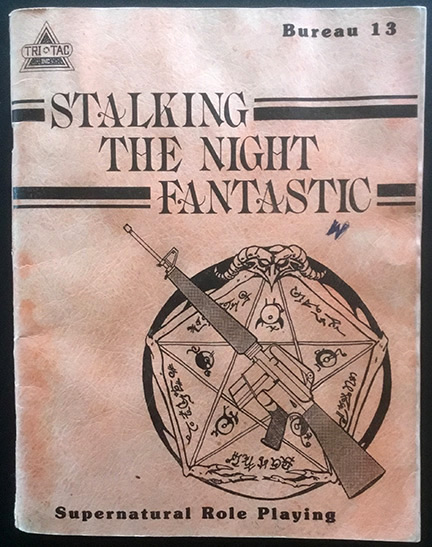


2. Lost Souls (by Joe and Kathleen Williams; published by Sage Lore Productions in 1992)

This game is all about playing someone who has died. Your age, physical features, personality traits, interests, ghostly visage, profession while alive, type of lost soul (apparition, banshee, wraith, etc.), unfinished business, and a number of other elements are determined randomly. There are 12 base skills rated from 2 to 19 (with other skills attached to them): agility, alertness, charm, cunning, dexterity, fate, intelligence, knowledge, mechanical, nature, stamina, and strength. I'm not sure how I feel about lost souls having skills like this. I kind of picture something more ethereal. Each earthly profession (like scholar, artist, or private eye) dictates how to determine the rating for each base skill, along with a random cause of death. The type of lost soul dictates the character's consistency (solid, luminous, or vaporous) and special powers. The outcome of using skills is determined by making a percentage roll and consulting the action table; there are five levels of failure and five levels of success. Difficulty can be modified by skill adjustments or outcome column shifts. Contests are resolved by best outcome. There's some interesting elements in the mix, including mediums (clerics, psychics, etc.), evil entities, planes of existence, hazards, and even a sample adventure. This is a solid game, much lighter in tone than White Wolf's Wraith, but I suspect it needs a committed group of players. I'm not sure I could get more than one adventure out of it. Fortunately, you can make your own decision on that point, since it has been made freely available for download by the author (Link).




3. NightLife (by Bradley K. McDevitt and L. Lee Cerny; published by Stellar Games in 1990/1992)

This came out around the same time as White Wolf's Vampire: The Masquerade. In a nutshell, it is World of Darkness (WoD) without the angst and in only a few books. Whereas World of Darkness splits up the various playable creatures into factions, NightLife simply lets you play a vampire, werewolf, ghost, daemon, wyght (otherworldly being), inuit (nature spirit), or animate (created beings). There are 8 abilities determined by 4d10: strength, dexterity, fitness, intellect, will, perception, attractiveness, and luck. Similar to WoD Vampire, a character's humanity is tracked. A number of skills are determined by adding 1d10 to a base value (typically the linked ability), and each creature gets is own set of edges (powers). Skill rolls are essentially percentage rolls. The game takes place in New York City by default. Various locations are described, as are groups, factions, gangs, and the like. An interesting addition is that you can also play other creatures as an option, including medusae, goblynnes, and sidhe. There's also a section on important NPCs to add more flavor to the setting. Perhaps not as elegantly produced as WoD, I consider this game to be a true classic, worth checking out if you can find a copy.




4. Revelation (by James C. Taylor Jr; published by Happy Nebula Adventures in 1998/1999)

The cover is certainly interesting. An angel with a machine gun. This has got to be wild. Of note is that the GM is called G.O.D., the Game Operations Director. Alien entities that people think to be demons are invading our world (there are also vampires and such). A secretive group who knows the truth, rather than thinking it to be the End Times, hunts down these creatures. Characters consist of 10 attributes: agility, speed, strength, vigor, appearance, demeanor, intelligence, knowledge, perception, and tenacity. Interestingly, these attributes are rated by a die code: d4, d6, d8, d10, d12, 2d8, d20, or 2d12 (or more for the supernatural). Is this the first such use of this in a game? Virtues and shortcomings can also be chosen. Skills are rated linearly, from 1 to the linked attribute's die code (d4 would be 4), although 4 is the maximum at this point. They basically add their value to a die roll (a d6 attribute and skill level of 2 would be d6+2), which would need to beat the difficulty (contests go to the higher roll). We get magick powers, psionics, miracles, and supernatural creatures. I really want to like this. It sounds like a fun game. Something just feels missing. I can't put my finger on it. Fortunately, you can make up your own mind, as it is still available in PDF format.




5. Abyss (by Marco Pecota and Wes Johnson; published by Global Games in 1997)

Set in the world of Dante's Inferno, this is pretty dark. Basically, everything is demon-like. You get to pick your own race, whether it be gnome, elf, minotaur, or whatever -- it doesn't really matter. There are plenty of samples to guide you. Each character has 3 vitalities (rated 1-20): physical, mental, and magical . Then there is a defense rating for each vitality (1-3), and essence and perception ratings. Skills are rated with a formula, typically determined by one or more vitalities. Tasks are handled by rolling the number of dice specified by the skill, reducing the number of dice by a value specified by the difficulty. If at least one 6 is rolled, the task is a success. Magic spells are handled in a similar manner. A number of scenarios are included to give you a feel for the game. I have two problems with the game: rules organization and the font used for setting information is very hard to read. It's a very interesting concept, but I'm not sure I can get into the setting. Of course, the rules can be borrowed for any setting, but there are other systems I'd use. This is another game that's stuck in limbo for me (pardon the pun). While I generally like the art, I don't think it conveys the setting properly.




6. Wyrd is Bond (by Jason L. Blair; published by Key 20 Publishing in 2003)

Think street gangs and rappers with magic instead of guns and mere words. Kudos for a very unique concept. Players portray slingers, or gangstas that use magic. Unlike most other games, characters do not have any set attributes. Instead, the gang they join describes certain elements, like intolerances, clothes/colors, symbolism, musical sound, and weaknesses, as well as special tricks, bonuses, and the type of slings (spells) they use. Juice is the character's fuel for slinging. His gang dictates how it is gained (or a personal ritual is used). Slings are like spells, but very open and free-form. They can do damage or perform some trick. 3d6 are rolled to sling, with each die placed under either order, power, or payback to determine the outcome. The difficulty determines the value needed on the power die (2+). For opposed rolls, the highest power die wins. Special traits can add or subtract dice for the roll, but only three dice are placed. Skills add extra dice and they are placed next to the regular dice. Here's the catch. If the character does not have enough Juice to fuel the sling, its power is reduced to whatever amount of Juice he has. On to the other placed dice. Order determines the speed at which the sling is cast (who acts first), while payback provides special effects like rolling over payback to order or power for the next roll, or absorbing damage. That's basically the game. There's no huge meta-plot or complicated backstory. It's gang vs. gang in a world of slinging magic. A few sample scenarios are also provided to help guide you into this world. It's a fun system, but long-term play probably needs a very immersed group and evocative GM. This is a short book, just under 100 pages, for those who want to get more done with less reading. My only real nitpick is that the header font is hard to read (it mimics tagging).

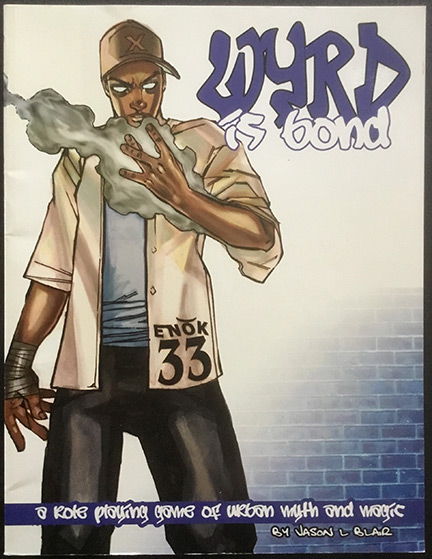


That's another batch done. I'm considering universal systems for the next set, but I'm open to suggestions. Probably, another installment of fantasy after that. If you're looking for similar games, Precis Intermedia's Bloodshadows is a mix of fantasy, noir, magic, and horror; Ghostories focuses on supernatural mysteries in a concise yet packed book.


Part 4... | | 0 Comments | Add Comment | Permanent Link | See All Posts Tagged as "ForgottenGames" | | Read more... | |
This is part 4 in a series discussing forgotten RPGs (Part 1 can be found here, Part 2 here, and Part 3 here). That is, games most people have never heard of or that didn't last long on store shelves for one reason or another. This batch consists of universal systems for the most part. These games have been sitting on my shelf for years, mostly ebay finds to add to my collection.


1. World Action and Adventure (by Gregory L. Kinney; published by M. S. Kinney Corporation in 1985)

I've seen the occasional mention of this game on the internet, but I don't think people, especially the younger gamers, have heard of it. This hardcover book is printed on very heavy paper stock, making it look thicker than other books of the same page count. Everything inside is black and white, but it is professionally printed. Chapter one contains a pretty good introduction to roleplaying with an explanation of random tables and scenarios. There is a lot of discussion of various types of possible die rolls and their issues. I'd probably be lost here as a newbie. Then there's discussion of maps and scales, with lots of samples. Chapter 4 finally brings us to characters (actors). The first factor is how close the character is to the player, whether morally, physical, totally, or completely different. Characters have 6 traits: strength, health, intelligence, endurance, looks, and dexterity. These are either determined by rolling a d20 (1-3 is a 12) or choosing the relevant score for each that matches the player's self. A rank (2-14) is then looked up for each trait depending on the character's age. There's lots of tables for determining how much you can lift, how many check up rolls you need per year for health and intelligence, movement rates, etc. There's also a history chart for the character's family and occupation/salary charts. Combat is similar to D&D: a to-hit rating is cross-referenced with a protection score to determine what must be rolled on a d20. Lots of options and tables follow. After that, we have random encounters and then miscellaneous charts, lists, and tables. I'd say that it's kind of like GURPS but without all the dis/advantages. I had to go back to look for rules for basic tasks. From what I can gather, it's a d10 roll with 3 difficulty columns. This means that non-combat actions are totally random based on the degree of difficulty. However, there are multiple outcomes. There's another table to randomly answer Yes/No questions. Interesting concepts, but completely relies on the GM's assessments. This game has some interesting concepts and good random tables.

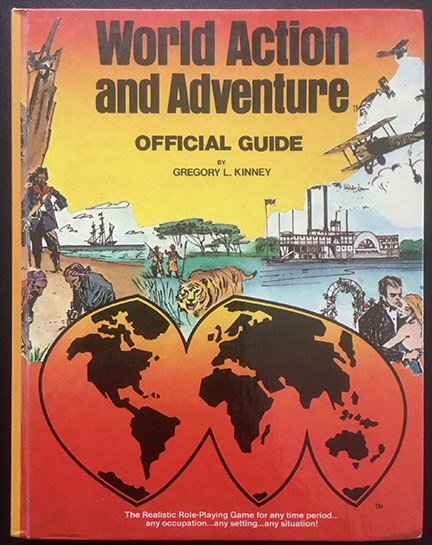


2. Adventure Maximum (by Dennis McDonald; published by WorldMaster Designs in 1992)

First impression of the interior is that this book looks old, like early 80's old due to its use of the Prestige Elite and Cursive fonts (or whatever they are). Page 7 gives up a Master Chart containing failures, critical, and chance of success based on active rank and opposing rank/difficulty. Seems simple enough. There are 10 attributes: intellect, strength, dexterity, condition, speed, willpower, ego, psyche, wealth, and reputation. Make a D% roll for each to get a score between 10 and 40 on a table. There are base abilities (like combat and movement) and resistances (like toughness and magic), all determined by averaging certain attributes. There's also disadvantages, a ton of skills, and special abilities. While the character sheet reminds me of early versions of the Hero System, it's all pretty easy and well-organized. There are some specialty rules like personality profile, but I'm sure you can just ignore that if preferred. Here's an oddity. Skill rank is the 10s digit of the attribute/skill rating, so a 62 would be 6. remember that chart? Use that 6 as the active rank and either the opposing rank or a difficulty (0-15) for the other side. A D% roll determines success as indicated on the chart. Again, pretty easy. I'm not sure what happens with the second digit of the skill rating other than being a stopgap for using experience. Luckily, the rules are nicely unified, so there's not much difference for combat, other than modifiers and some special cases. That covers up to page 88. The rest of the book covers equipment, cybernetics, magic, GM stuff, and notes on adding fantasy races. This feels like a modern system, but in a true retro shell. I would give it a shot if I didn't have a plethora of other systems. Also, the art is sparse, but I like what's there. My question is whether this could take on Hero System? I noticed that a newer version is available; I don't know what the differences are, but the preview suggests that the D% has been replaced with D10 (Link).

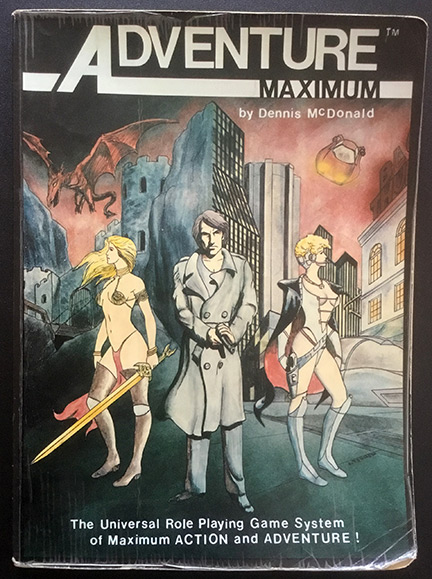


3. Eternal Soldier (by Chris Arnold, Rob Arnold, and Joe Mays; published by Tai-Gear Simulations in 1986)

Not a fan of the cover, but let's see what we've got. The layout is from the early days of computer design, one that is very easy to read. Straight to business. There are 8 statistics (also called attributes in places; rated 3-18): strength, agility, dexterity, constitution, intelligence, will, comeliness, and charisma. That sounds familiar. They even use modifiers from -4 to +4 for these statistics. Attribute rolls or saves are d20 roll under score. Base skill levels depend on the statistic, multiplied by a particular value for each skill involved, totaled, and then divided by 10. Then extra points can be applied. It took me several reads to figure that out. It doesn't help that the chart was tiny. Using a skill means rolling D% under the skill rating. Combat is a skill roll, but there's no defense involved unless some sort of parry or defensive action is taken, which then modifies the damage. I kind of gave up at this point. It very much feels like someone's D&D upgrade. I'm not saying it's a bad system. It's just not for me. There's a few pieces of art, but they don't really add to the book.




4. QAGS (Quick Ass Game System, Second Edition) (by Steve Johnson and Leighton Connor; published by Hex Entertainment in 2003)

This is on the newer side, but I never hear anyone talk about it. This is like the anti-GURPS. It's whimsical and states for mature audiences. I particularly like the "How dice work" diagram. There are basically 3 abilities (rated 6-16): body, brain, and nerve. Then there is a character's job, rated between 6 and 19, followed by gimmicks (unusual traits that are facets of an ability), and weaknesses (the latter two starting at a rating of 10). We also get skills, which are essentially bonuses. Simple rolls are d20 roll under ability and weakness rolls are d20 under weakness. Combat isn't much different. The system itself is very simple, but the book also offers GM advice and some thoughts on running specific genres. The beauty of the game is that it is well-supported with a number of setting books. If you don't mind simplicity and cheekiness, check out Hex Games.

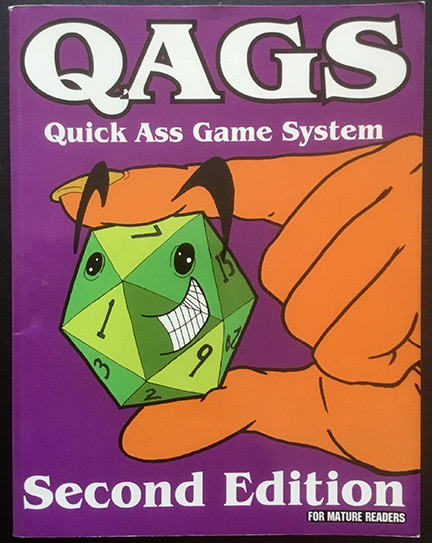


5. Persona (by Kevin Muñoz; published by Tesarta Industries in 1996)

This is a universal Diceless system, though it doesn't feel like one. When I designed Active Exploits Diceless, I wanted it to feel like a traditional RPG rather than how Lords of Olympus and Amber somewhat rely on fiat and simple comparisons (yes, I know there is more to them than that). Nothing wrong with either way, but they are different mechanisms. Persona takes my concept of being like a traditional RPG even further, as there are a lot of numbers involved. Characters consist of 4 foci: physical, emotional, mental, and spiritual. Each focus has the same 4 related attributes: frame, endurance, reaction time, and dexterity. Each focus also has one unique attribute: combat for physical, phobia for mental, technology for emotional, and detection for spiritual. Foci are rated on a scale from 1 to 20, but that scale can be relative. There are also skills linked to particular foci. The gist of the system is that you apply all modifiers, a focus, and possible skills to compare values to see who wins. That's pretty standard for a diceless game. I've never played it, as I discovered it after creating Active Exploits, but it seems solid. There's a good amount of options, like broken weapons and mass combat. I'm not sure you'll be able to find a copy, but it may be a good fit for someone interested in another take on diceless gaming.

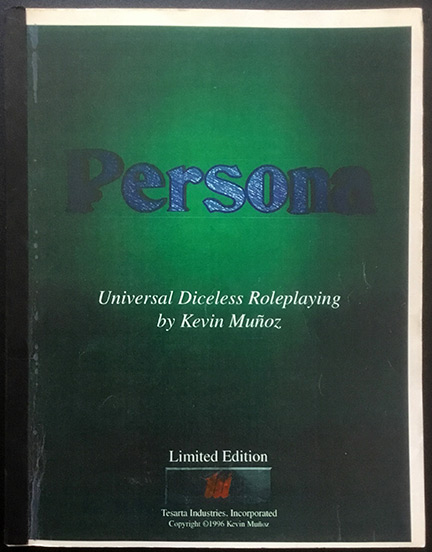


6. So You Wanna Be a Rock 'N' Roll Star! (by William A. Barton; published by Bill Barton Games in 1988/1990)

I saved this one for last. It's not technically a universal system, but why not use it that way? It's about becoming a rock n' roll star, but what is involved in that goal? There are 10 attributes (rated 3-18): strength, dexterity, constitution, intelligence, perception, charisma, luck, drive, talent, and originality. There are other random factors, like hair color, appearance, prior professions, and education. There's some quirks and special abilities (yes, there's ESP powers). Probably of special importance is the instruments you can play, how well you sing, and writing ability (based on your talent score). Next, we have skills -- there are three levels: amateur (+1), professional (+2), and expert (+4). More info covers bands and what goes into them. Skill rolls are 3d6 roll under the attributes/skill level, adding more dice for harder tasks. When it comes to rumbles, there's an action chart that reminds me of Hero System. Combat is essentially the same as skill rolls, but defenses can increase the number of dice rolled. Next, we're hit with setting material, sample scenarios, etc. This feels like Scooby Doo or Josie and the Pussycats sans the mystery elements. The art matches that sentiment. I like it, but I don't think there's anything here I couldn't do with any other system. High Strung does a similar job, but in fewer pages and with more emphasis on being successful as a band.

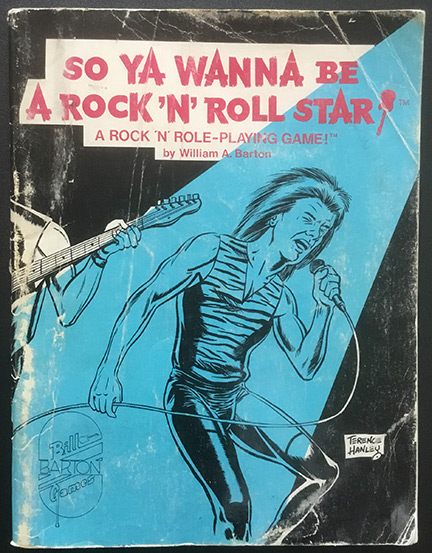


And we're at the end of another batch. Perhaps the next set will be weird and wild, back to fantasy, or a mix of the two. We'll see.


Part 5... | | 0 Comments | Add Comment | Permanent Link | See All Posts Tagged as "ForgottenGames" | | Read more... | |
This is part 5 in a series discussing forgotten RPGs (Part 1 can be found here, Part 2 here, Part 3 here, and Part 4 here). That is, games most people have never heard of or that didn't last long on store shelves for one reason or another. This batch consists of strangeness, odd games that belong in categories all their own. These games have been sitting on my shelf for years, mostly ebay finds to add to my collection.


1. Attack of the Humans (by Devin Durham; published by Rapport Games in 1990)

Now falling apart, this game is a humorous take on monster-hunting. There are three types of characters: brainiac, athlete, and typical person. These determine the values for the three attributes: brains, fitness, and common sense (a mix of two 5s and a 10 for the first two, and all 7s for the latter type). A character's IQ can be calculated by adding brains to half of common sense, and multiplying it by 10. Fitness describes how many pounds a character can benchpress, which is its rating multiplied by 15. A number of rolls are made for each attribute based on the rating. This provides a random skill or bonus, with duplicates increasing its level. Using a skill is as simple as rolling less than its level on a d6, with 6 always being a failure. Combining skills for a task increases the odds. For combat, a d6 and d10 are rolled, needing to roll under or equal to a base of 8. Skills, weapons, and other factors can augment this value. It's a very simple system. As expected, there are a bunch of monsters described, such as blobs and chainsaw creatures, spanning pages 46 to 73. Sample adventure material completes the book. It's basic. It's less than serious. Most importantly, it would make a great one-shot.

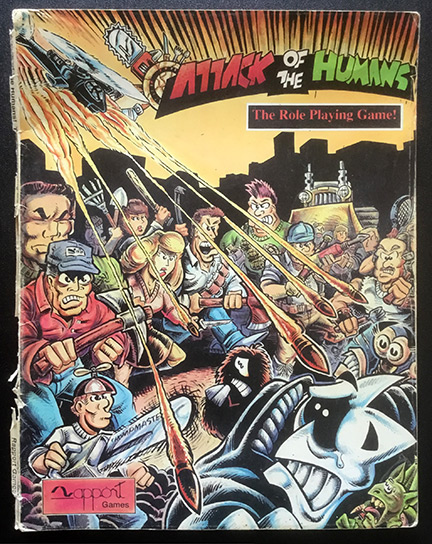


2. Mutazoids (by Ken Whitman and Christopher Wilkey; published by Whit Productions in 1989)

The short version is that someone created a cancerous plague that killed a lot of people. New governments formed, old ones were reborn, and some infants were being born with deformities. The characters are Enforcers tasked with keeping the peace by defending the public against the Mutazoids, or the dangerous deformities. There are seven primary attributes (rated from 2 to 12): physique, constitution, dexterity, intelligence, power, charisma, and perception. Rank and years on the force are randomly determined. Skills are rated from 0 to 12, and are gained randomly by rolling on charts according to years on the force. Creating non-human characters (superhumans, mutazoids, and acceptables) are also possible, so there are lots of tables and other info for mutations and powers. Fun stuff. Doing things requires the Universal Task Roll Table, which cross-references skill/attribute level and difficulty to determine a value that must be rolled equal to or under on 2d6. Combat pretty much works the same way, with options to modify difficulty. There's lot of stuff covered here, including falling damage, vehicle combat, and using drugs. The last part of the book touches on Enforcer rules, laws, setting material, and gamester notes. This game is very representative of the era, both system and setting-wise. I like it. While the system is not my favorite, it is serviceable. Note that this is the first edition, but there is also an updated second edition with more setting material. These appear to be available again through FireSide Creations, as is a third edition that is d20 compatible.

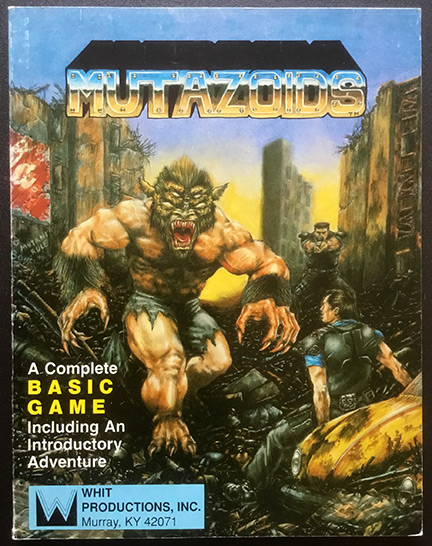



3. Machineguns & Magic (by William L. McCord Jr.; published by MG Games Inc. in 1991)

Did you ever want to pit a group of soldiers against a horde of orcs? Here's your chance. That's pretty much all this game is about, but it's a unique concept. There are three primary stats: muscle, agility, and alertness. Each one is rated by a d% roll, and modified by +30, +20, +10, or 0 for each (depending on the original value and a roll on a table). There are two secondary stats: magic resistance (derived from primary attributes) and luck (50). There are also personality facets and these can create conflicts in the game. Checks and saves are done by rolling d% under the primary stat. Combat is pretty much a check, but the higher successful roll (attacker vs. defender) wins. Magic is very similar, with spells defining the type of defense (none, magic resistance, etc.). After ALL the rules, we have a bunch of creatures like skeletons and slimes. Most have special rules attached. We round out the book with an adventure called The Quest for the Gem of Purity. I don't know what else to say. I have mixed feelings. It's got lots of examples to explain it, but I'm not a fan of the organization. It seems to cover all the bases, but feels lacking. The character sheet is reminiscent of the classic Traveller sheet by its organization.

UPDATE: Machineguns & Magic is now part of the Precis Intermedia family of games. I acquired the rights after learning of the author's passing, as I have a soft spot for this title, particularly the writing. I believe that this game deserves more attention, as does William McCord's legacy.

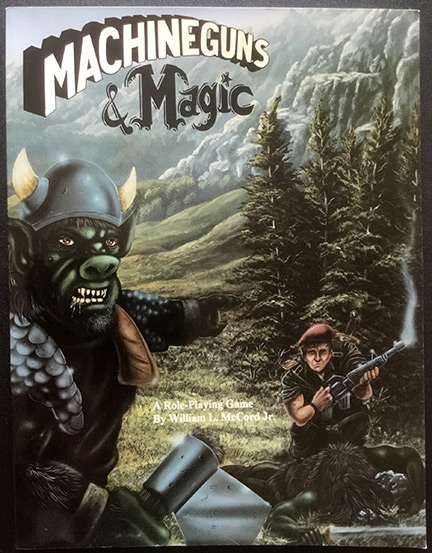


4. World Tree (by Bard Bloom and Victoria Borah Bloom; published by Padwolf Publishing in 2000)

This is a "roleplaying game of species and civilization." The world is a big tree. And it is populated by intelligent animal species. I don't understand about the tree, but sure. The first 100 pages details the setting, various species, and all that important info. 100 pages! That's a lot of setting before any rules. I'm not really into animal species as a whole, and it's a lot of information to remember as a gamemaster or player. So far, I'm not into it. We are first presented with attribute/skill rolls, which are d20 + attribute + skill equal to or greater than a difficulty. Combat is essentially highest roll. There are 10 attributes (rated from -6 to +6, although -1 to +3 are common): strength, stamina, dexterity, agility, perception, faith, memory, wits, will, and charisma. Skills seem to range from 1 to 20, though those tops levels are likely not going to be seen for a while. Everyone gets magic. Some of these spells have great names, like carry the slain beast and heal the body's weapons, though most are mundane. For species, we have dog folk, bear folk, isectoids, octopi, dragons, and the usual suspects (though they are given custom names, making them hard to remember). Lots of discussion on skills, combat styles, magic, and the like. Keep in mind that this book is over 300 pages and the type is very small. It's a lot of reading and it's a drag. Don't get me wrong. There is a lot of interesting stuff in here, particularly the magic. The art is typical for anthropomorphic animals, but the bestiary section let me down in the art department, and everything has a custom name that doesn't connect with the creature. That means I won't remember anything. This game needs a really good gamemaster to immerse his players in a very alien world. It needs players willing to accept that world. My suggestion is to mine the setting and magics for ideas for other games.




5. Dallas (by James F. Dunnigan; published by SPI in 1980)

Yes, it is Dallas, the television series as an RPG. Guess what. It's not bad. This is a boxed set with several booklets. The main rules are only 4 pages, but with the usual SPI small print (the rest of the booklet contains episodes, or adventures). There are 4 abilities, split into affect/resist values: persuasion, coercion, seduction, and investigation. Wow. That actually does sum up the show. Characters also have power (general strength for negotiating and overcoming conflict) and luck. All the minor characters are described on small cards, while the major ones are contained in a separate booklet. Here's the interesting part of the game. You can persuade, seduce, or coerce minor characters so that you gain control over them -- your major character essentially allows you to control them. Back to rules. You subtract the resisting ability from the affecting ability rating (modified by power and special bonuses). You need a difference of 2 to 11 to make a dice roll, with 12 or more automatically successful. The dice roll must be equal to or less than the difference to succeed. A luck roll is also possible by the resisting character (roll equal to or under luck rating). There is a scriptwriters guide booklet with director's notes and character biographies. The game is limited in scope, but I think it does a great job of emulating the series. Home run in my opinion, though it will not replace your regular RPG.

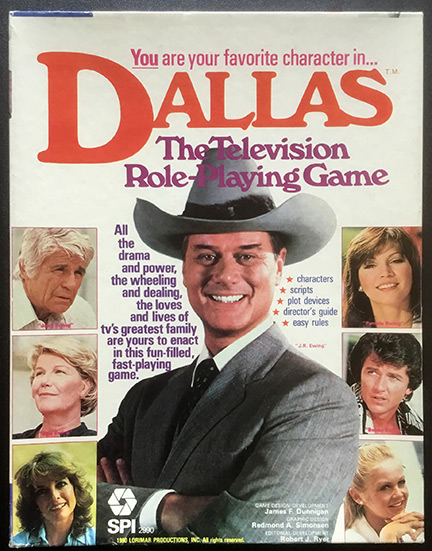


6. Excursion into the Bizarre! (by Wolfgang Trippe and Brian Carlson; published by Blind Dog Games in 1985)

Kudos if you've heard of this one. This is a rather odd duck. It claims to be a complete game, but is it? Here's what it is. You can play an animal character from the dimension of Chon-Blu or a fantasy character from the magical dimension of Oort. And apparently, you have unreliable magic skills. Great. Characters get five traits (roll 5d6, dropping the lowest die for each): strength, constitution, agility, intelligence, and wisdom/intuition. Using a trait means rolling equal to or under your trait rating. One problem: what dice do I roll? If attributes can range from 4 to 24, what die or die combination would work? Do I roll 4d6? It just does not say. It merely says to make a die roll*. Let's move on to skills. The number of skills you get is determined by your intelligence, but you can't start with earth skills (those marked with an E, like compound bow and paramedic). Divide 250 points among your skills to determine a percentage for each. Wait. That means if you get fewer skills, they get rated higher, because there are fewer skills to worry about. Does that sound right? So if skills are percentage-based (roll equal to or under their rating on d%), does that mean that the attribute's rating is also a percentage? Attribute rolls are also d%? This section is followed on info about the dimensions from which you may have come before reaching Earth. Some weird stuff. There's talk of enemies (like IRS and Miami Vice), allies (such as Steven Spielberg and the Libertarian Party), and neutrals (like mental patients and punkers) on Earth. And human reactions to dimensional invaders get a roll. Let us not forget magic. Casting a spell depends on how long the character has been on Earth, more time being better, but still not with great odds. Here we go with combat. We're mixing it up. Consult a table with each side's agility for hand to hand, rolling equal to or over the shown value on a d20. Melee is different. For every 5% in a weapon skill, subtract 1 from 20 -- roll equal to or under this on a d20. It talks about a parry, but what happens when it is successful? Does the successful attack just miss? Firearms just seem to be random with modifiers applied. My brain is starting to hurt trying to decipher the rules. There's some scenarios and a few random tables to round out the game. I remember being excited to get this game, because it sounded cool. Unfortunately, it was a real let down.

*EDIT: Turns out there is a line of errata in small type after the adventure on page 55 that explains saving rolls against character traits are made with 4d6.

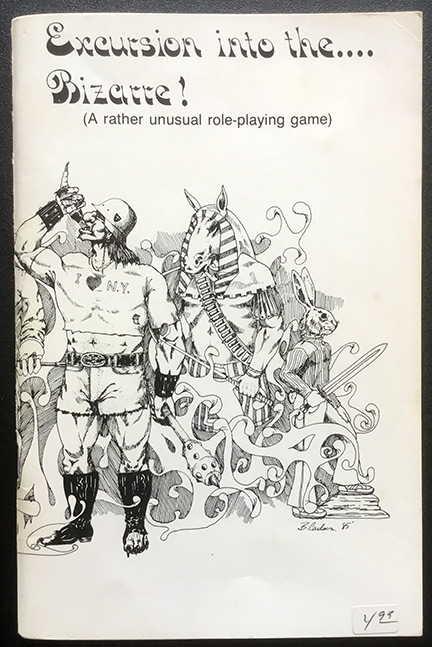


I think we'll double back around to fantasy next time.


Part 6... | | 0 Comments | Add Comment | Permanent Link | See All Posts Tagged as "ForgottenGames" | | Read more... | |
This is part 6 in a series discussing forgotten RPGs (Part 1 can be found here, Part 2 here, Part 3 here, Part 4 here, and Part 5 here). That is, games most people have never heard of or that didn't last long on store shelves for one reason or another. This is another batch of fantasy games. Some of these games have been sitting on my shelf for years, but some are recent acquisitions, mostly ebay finds to add to my collection.


1. Wizards Realm (by Cheryl W. Duval, Niels Erickson, William G. Murphy, and Clifford Polite; published by Mystic Swamp in 1981)

This book is odd in that it uses a two-column format in landscape orientation, making it a bit awkward to read. The art is rather "cutish," and the ornaments take up every inch of free space, making it seem fuller (it works). The game uses d6s, d10s, and d20. Characters have 8 attributes determined by rolling 2d10 for each: strength, intelligence, constitution, dexterity, agility, charisma, appearance, and luck. There are 8 playable races: Humans, Dwergars (Dwarves), Elves, Hobbitry, Bogeys, Orcs, Goblins, and Trolls. There are 3 classes: warriors, spellcasters, and adventurers. Skills are acquired with skill credits, which basically increase the base percentage odds, depending on the type of skill. Basic skill use appears to be a 50% chance with one skill credit applied (increased with multiple skill credits). Combat is 1d20 + Attack Base: Strength + Dexterity + Agility [- Armor penalty] [+ weapon bonus if applicable skill credits were applied] minus 1d20 + Defense Base: Strength + Intelligence + Constitution [+ weapon/shield defense] [+ armor rating]. The difference is damage deducted from the Defender's Survival Points (Hit Points). I sense a pattern with these older games of skills not working the same as combat. It's like they based everything off the D&D rules, but in different directions (I type this sarcastically). Anyway, there are various types of combat results that make the game more interesting, which are basically critical hits. There's rules for mass combat, movement, magic (similar to skill use), and even for creating new monsters. A sample adventure is also included. I don't like using that many attributes for combat rolls, but I do like the approach to dealing damage. I'm glad I have this game, though it's not something I would play.

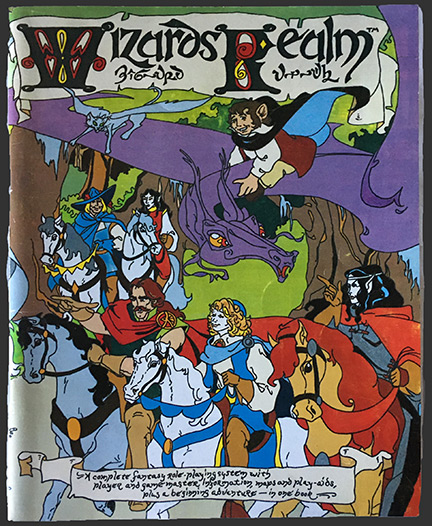


2. The Realm of the Gateway: The Magic Realm (by John Griffin and Matt Nixon; published by Griffin Games in 1996)

We're basically dealing with a multi-dimensional world, so that fantasy and magic can mix with starships and blasters. Since I only have this first book for fantasy, I don't know how well this melds. Characters have 6 attributes: strength, agility, constitution, intelligence, charisma, and will power. The race you choose determines how to roll for their ratings, but the base is 2d10±modifier. Skills seem to be level-based. Using skills consists of rolling under the ability + skill level on a d20 (I thought abilities were called attributes -- they seem to be losing consistency). Combat rolls are D% plus average of strength and agility plus 10 per level of weapon skill, and ± modifiers MINUS defender's roll (similar, but depends on how defending). Then the difference between the two are consulted on a chart determined by the type of defense (dodge, parry, or shield parry). Then an attack chart is referenced for the amount damage, potentially modified by the previous chart. There are different types of damage levels for different types of attacks, which seem to result in die rolls of damage to hit points (or whatever they are called). Interesting system with lots of damage options for various forms of damage.

Stop. Very confusing. I am now presented with Book One: The Magic Realm around page 81, with a new table of contents and the page count starting over. This is where character creation can be found. Later chapters include discussions of psionics (just my personal preference, but I don't like mixing psionics with fantasy), animals/creatures, magic. I'm just gonna come right out and say it: the organization sucks. If you want to check out this game and its subsequent books, they are available here, seemingly as newer versions. I like the premise behind it, but it's just not for me.




3. The Legend of Yore (by Brennan Taylor; published by Galileo Games in 1995)

I think it was RPGPundit who said that game fiction in the beginning of an RPG is never good. I tend to agree. I don't buy RPGs for the fiction. That said, it can help explain the setting and set the mood. This game starts with some fiction. It's a fantasy game, and seemingly traditional at that. I'm just going to skip it. I mean no offense to the author, but I just don't want to be bothered with it. Some may argue that they like good game fiction for the purposes I previously mentioned. That's fine. I'm not going to tell anyone what they should or should not like. I just wonder what people actually think of it in general (let me know).

With that rant out of the way, let us proceed. We're dealing with d10s and the gamemaster is called GOD. We get a quick reference of page numbers for various character creation components. Nice. We get 7 races (Humans, Elves, Dwarves, Goblins, Giants, Trolls, and half-breeds) and various ethnicities for each. Various backgrounds can also be applied, depending on race. There are 8 characteristics (2d10 for ratings, ± modifiers for race): strength, constitution, agility, willpower, knowledge, perception, beauty, and combat (this one is the average of strength, agility, and perception). Then consult a table to determine a base percentage for each rating. Next, background/profession skills are chosen. So a skill roll is the characteristic base percentage + 5% per skill level as D%. Combat/contested rolls mean that the defender rolls first, with his result (if successful) reducing the attacker's base percentage. Seems like a solid system, with the typical fantasy elements, like magic and creatures, following this point in the book. I probably would have given this system a try back in the day. It feels like something I would have done back then.

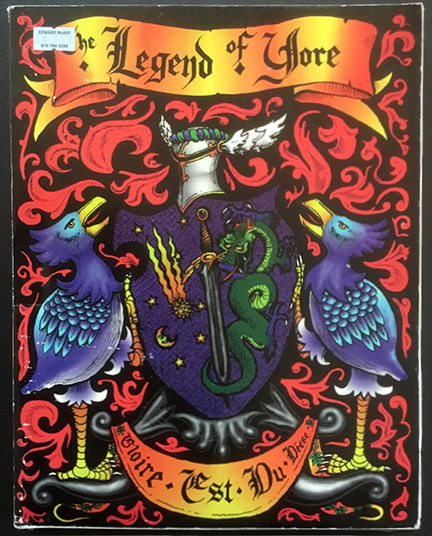


4. Pelicar (by Pharaoh Games; published by Ivory & Steel in 1996)

We get right into character creation. There are 8 attributes (3d10 for each): strength, stamina, reflexes, mentality, piety, sanity, senses, and beauty. That seems to cover a lot of bases. We move on to professions with lots of different types of magic-users. There are a number of the traditional races, plus a few unique ones, including a feline species. Attribute tables follow with the familiar method of applying modifiers for various uses (like attack or movement). There are different ways of gaining percentage-based skills, include from ancestries and trades. Combat is a D% roll plus applicable modifiers vs. a defense rating (beat this rating). This game kind of feels like Dangerous Journeys -- I'm not sure why, perhaps the explanations and the layout. The rest of the book discusses magic and creatures. The character sheet is like a d20 sheet in that it lays out all the modifiers. Lots of random tables for stuff. I don't see anything particularly wrong with the game, but I think it could have been greatly simplified in the execution and explanations.

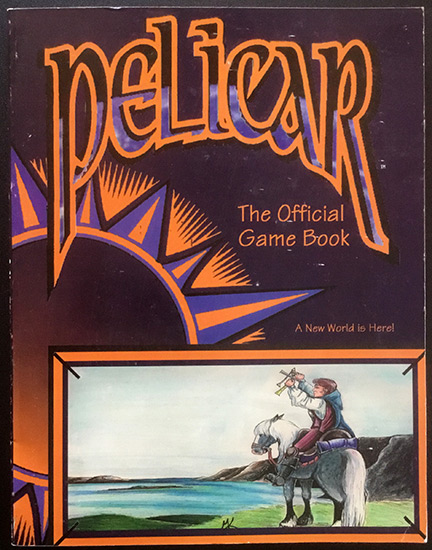


5. Darkurthe Legends (by Mathew Yarro and Colin Murcray; published by Black Dragon Press in 1993/1994)

This dark fantasy RPG gets right into it with character creation. There are 6 primary attributes (2d6+4 for each): strength, agility, willpower, intellect, person, and faith (this one depends on race and alignment). The typical fantasy races are here, plus corrupt versions and lycanthropes. Race orders are classes tailored to specific races, providing specific skills and other elements; these include Deathmasks, Necromancer Kings, Warlocks, Merenaries, etc. Characters can belong to guilds, cults, clans, and royal courts for added benefits. Skill use requires a table that provides a base success number determined by the appropriate attribute; roll d20 plus skill modifier to roll over that number. Combat is similar, but the skill modifier is determined by subtracting the defender's combat ability from that of the attacker. An attack/damage table is then referenced based on the rolled result. The magic system is particularly interesting with LOTS of modifiers for casting rolls, and variable ranges and durations. The various lands are described and the dark fantasy elements are clearly laid out, such as corruption and evil. Some of the creatures are particularly nasty (in a good way). While the system is not my cup of tea, the setting, magic, and creatures are ripe for adaptation to other games.

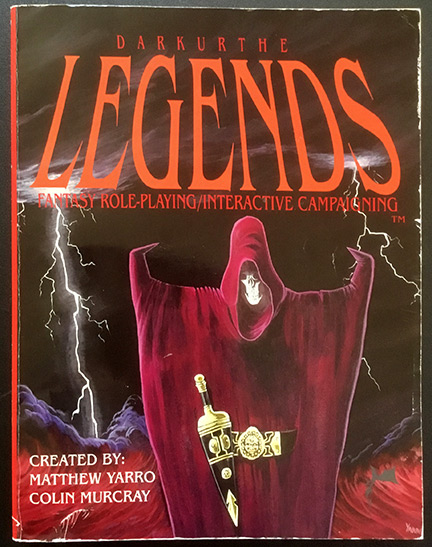


6. Monsters and Slayers (by Clifford Raymond Fagan; published by Atlantis Enterprises in 1991)

This is an interesting take on fantasy roleplaying. The setting is the British Isles of 537AD, but only because that's what it says. It doesn't really matter where you set it. Your character is a slayer, who goes around doing things for money: monster hunter, contract killer, etc. Only d6s are needed, which is always good. There are 7 statistics (roll 4 dice and keep lowest 3 for each): strength, endurance, dexterity, intelligence, luck, persuasiveness, and attractiveness. Ability rolls are roll 3d6 under statistic rating. Resistance rolls are essentially saving throws, which are 4d6 under rating. Gnomes and Elves seem to be the default non-human races, but others like Valkyries (who can fly and cast freezing wind), Red Devils (cast fire spells), and Mermen (cast water spells) are also possible. Combat is similar with a 2d6 roll over 8 as the base (7 for slayers). Grappling is interesting in that it takes multiple opponents into consideration. Improvement consists of increasing weaponry, magic, and stealth masteries (which lower the base attack number). Various assassin skills are accomplished in similar manners to ability rolls. All slayers can cast magic by making a luck ability roll. Spells, magic items, and monsters are kept relatively simple, which means the game is fairly simple to run. An adventure is also included. Critical hits are also fun. This is a good game for fast-play without all the detail, but some may find it too basic. The author is selling his remaining stock on ebay (Link).

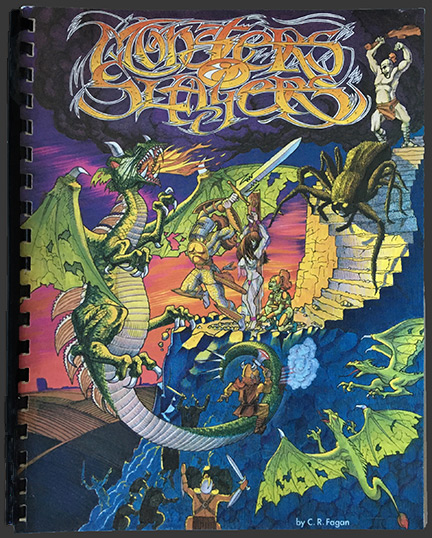


We're at the end of another batch. This one had some rough gems in it. This entry also comes with a bonus. I am offering a $4 discount on the Special Reprint of Lair of Sword & Sorcery, a fantasy RPG that is easy to learn, fast-playing, and probably unique in its approach. Just enter coupon code LBTZE3SRWQ at checkout with the Lair of Sword & Sorcery PDF in your cart to get it for only $7.95 $3.95.


Part 7... | | 0 Comments | Add Comment | Permanent Link | See All Posts Tagged as "ForgottenGames" | | Read more... | |
This is part 7 in a series discussing forgotten RPGs (Part 1 can be found here, Part 2 here, Part 3 here, Part 4 here, Part 5 here, and Part 6 here). That is, games most people have never heard of or that didn't last long on store shelves for one reason or another. This batch focuses on superhero and anime games. Most of these games have been sitting on my shelf for years, mostly ebay finds to add to my collection.


1. Comix: The RPG (by Anthony Parisi; published by Shiny Red Button Games in 2008)

This is a small book, only 50 pages in length. It is reminiscient of the Marvel Superheroes Saga game in its layout. It starts with a quick reference for character creation. Characters get 5 Stats; agility, brawn, moxie, smarts, and charm. There are two parts to each Stat, a rating (1-5) and a quality (these are kind of like aspects or specialties, rated good, bad, or normal). Single-letter abbreviations are used for the qualities, making it a bit cumbersome to keep checking on what they are. Each power is linked to a Stat/Quality, although this can be fluid. I started getting a little confused here. Powers are open-ended, which means you can create your own based on the concepts laid out. It's actually easy to create a character, but the sample process is a must-read. A dice pool is used for all actions, with the type of die determined by the setting, difficulty (level of randomness), and certain game elements. The dice are totaled with the highest value exploding on each. The concept of open checks and set checks makes sense, but determining what must be rolled needs about four re-reads. There's a table incorporating ratings and die types to determine difficulty, but it's not explained too well. It seems that a difficulty number can be computed based on an opponent's rating and die type. Then there's kicks and successes. There's a table for that, or reduce how much the roll was over what was needed by the highest result possible on the type of die rolled as many times as possible -- the number of times this can be done is the kicks and the remainder is the successes. The former is a narrative mechanism, while the latter is enforced by the specific action taken. The rest of the book discusses rules and some advice. I don't really understand the need for two different types of success indicators, but maybe I'm just missing something. It actually gets a lot done in a little space, but could be greatly simplified in its execution.

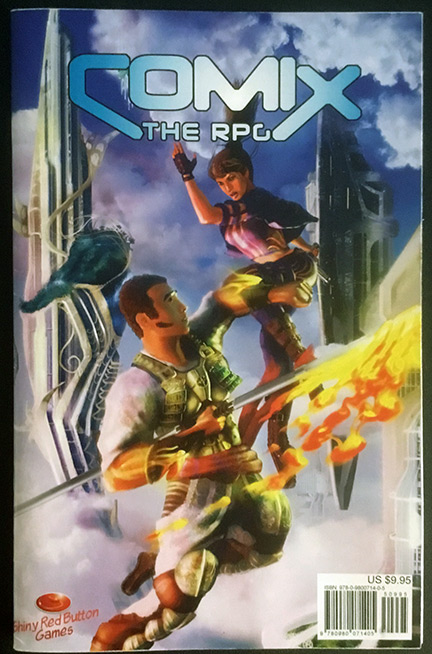


2. Enforcers (by Gary Bernard, Charles Mann, and Larry Troth; published by 21st Century Games in 1987)

This is billed as a super-powered science fiction RPG. It is intended to be played in a future setting. A calculator is recommended. There are six basic statistics (4d6, drop lowest): strength, constitution, agility/dexterity, intelligence, and comeliness. Yes, that is only five. There is also media rating, but this uses a different scale, with positives and negatives. Then we get to damage number (using character points beyond a base of 10), which is multiplied by the R-factor (2d6) to determine how much damage is inflicted for any given attack. There are formulas present at this point to determine how much extra it will cost in creation points and energy points. Lots of superpower descriptions, followed by weaknesses. Now we get to calculated statistics, which include hit points (more calculations and fractions), energy points, carry capacity, hand to hand, running speed, detective score, danger sense, healing rate, and knock back factor. Sheesh. All need to be calculated with formulas and fractions. Next is occupations and skills. I'm not even going to continue. This game is not for me. I don't mind a few calculations here and there (Supergame Classic requires a formula for combat and damage, but this is over the top). I do like the critical hit and fumble tables. I bet the system is not as complex as it appears to be, but I don't really want to figure it out. Showing its age, they included a Lotus spreadsheet script for character generation. There's also a striking lack of any type of setting, so other than gadgets being the powers, I don't see how it is science fiction -- it could just as easily be fantasy. Let me just finish up with the reference pages including A LOT of numbers. Strike that, I will finish up with the character sheet reminding me of early Champions, and the formulas are listed on it, so doing all the calculations on the sheet is probably not as bad as I made out (provided, you know what you are doing).




3. Heroes & Heroines (by James E. Freel III; published by Excel Marketing in 1993)

We're starting out pretty good with explaining comic book characters. There are five prime characteristics: bench press weight (actual weight), IQ (actual IQ), reflexes, agility, and stamina. The numbers for the latter three seem to range from 3 to 100+. Various modifiers are created by these values (like D&D). Powers work similarly, with ranges, weights, and damage costing a certain amount of points. Powers continue up to page 85. Combat is handled with a d20, rolling over a value determine on a table by cross-referencing attack and defense values. It's actually a pretty easy system, but I haven't been able to find anything on performing normal actions. A selection of animal stats is included, as is a sample adventure. This would have been simpler than most superhero games back then, and had a few supplements. If I had it back then, I might have tried it.




4. Super Squadron (by Joseph Italiano; published by Adventure Simulations in 1983)

I've been told that this game is still popular in certain parts of the world, but I haven't heard much about it locally. The picture shown is one of the main book, but it came in a boxed set with other materials, including an adventure book. This is another future-era setting, but actually includes information on the setting (unlike Enforcers). There are eight principle characteristics: strength, agility, charisma, intelligence, stamina, public standing, ego, and luck. Public standing starts at 11 and luck uses a table, but the others are determined by rolling a d20 (rerolling if enough are too low). The character's origin is important, and powers are rolled randomly. As with D&D, characteristics apply modifiers to certain actions based on their values. A D% roll is made for attacks, with various modifiers applied. There is a lot of good mechanical advice included, such as for imprisonment, social involvements, and daily activities. It's not my ideal game, but it has a lot of great ideas. A super-science supplement was also published for it, with tech for the setting.

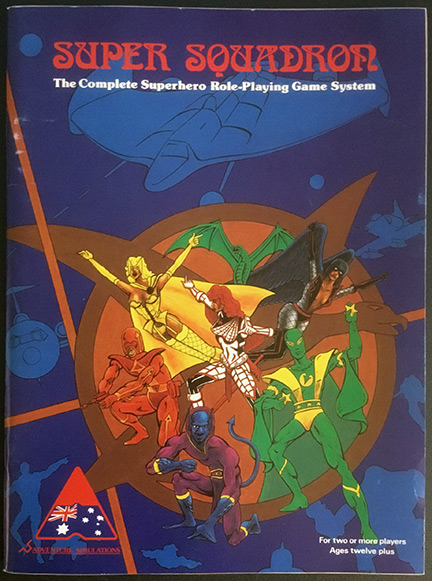


5. RandomAnime (by Brian J. Perry; published by Infernal Funhouse Productions in 2002)

Unlike the previous entries, this is a game about playing anime characters. We start out with a discussion of anime, roleplaying, and a glossary of terms. There are various levels of anime, which describe the amount of realism and suspension of disbelief. Characters are built with templates (like big bruiser, idol, kid, and old master) to determine bonus points and luck. There are eight attributes (rated from 1 to 10): strength, reflexes, endurance, perception, intelligence, wits, charisma, and resolve. The realm of anime (shojo, shonen, or sentai) determines how many points to allocate. Then come the skills in a similar manner. Backgrounds add more detail to the character, as do gimmicks (like bulletproof, mind trick, and teleport). After all the descriptions for skills and gimmicks are given, we get the mechanics on page 114. Yes, page 114. For actions, three six-sided dice are rolled: two are added together, while the third is a luck die and kept separate. If the modified 2d6 roll is equal to or greater than 10, the action is a success. The luck die can decide draws and apply extra damage -- it is just what it seems to be: a lucky die. Combat is handled similarly, with the attacker's difficulty (instead of 10) being equal to the defender's total. Most gimmicks and actions are divided into mechanical, cinematic, and mecha specifics, so various styles of play are supported. This is a pretty expansive and simple game. It probably lacks some of the subtleties of what anime fans like, and may have balance issues, but seems to meld anime with a roleplaying game in a way that doesn't make it too cumbersome. I recommened it if you can find a copy.

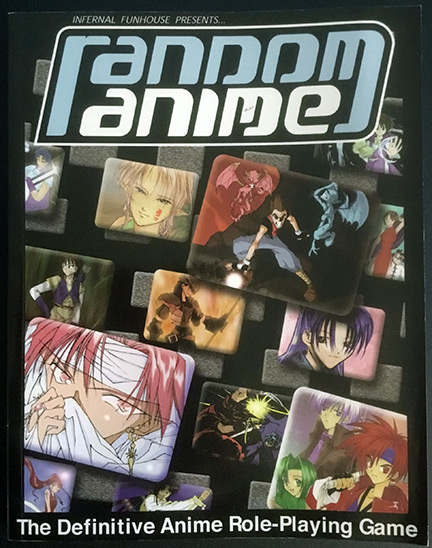


6. Aniventure (by James C. Talbott; published by Detarame Press in 2010)

My first observation is that it's a tough read due to the layout, but let's suck it up. Right in it with character creation. Talents are the basis of characters I am told. These are technique, fortitude, health, accuracy, evasion, recovery, prowess, cunning, acumen, logic, acuity, empathy, mien, style, and glamour. I wore myself out typing all that. Human average is 20, but the array of allocated points go as high as 60 or you can go as high as 65 with the alternate point buy. There are a number of classes, such as avatar, idol, and ninja that determine base dice pools and other elements like powers. Age category and looks are also important. I'm starting to think that this caters to a particular type of anime. I'm looking at a lot of large tables and getting overloaded. I like the amount of info, but is it useful? We've also got racial background archetypes like draconic ancestry and lethal chef. I guess these are basically like anime templates -- there's lots of them. The descriptions for all the classes and such follow. Tests of skill and chance use a pool of d10, with each pair being a success. Lower pairs are considered fast results, while higher pairs are strong results. So, depending on the action, a lower pair may be needed to beat someone when speed is important or a higher pair may be needed when force is needed. It gets a little complicated on what pairs (and how triples are used), but an interesting system nonetheless. When there is no opposition, a D% roll can be made to roll less than the talent. The Powers & Magic section includes just what it sounds like, but can be inspiring for your setting. That's a big section, as is the Equipment & Mecha chapter. The Gamemaster's Guide rounds out the book with advice, themes, and notes on various uses of the rules and alternatives. This book (and a supplement) is still available via Lulu (Link to author's site). It has great ideas, but I need more simplicity.




If you're into easy to learn and quick-playing superhero RPGs, check out my own Supergame Third Edition, a complete reimagining of the original Supergame from 1980/1982 (also available as a classic reprint incorporating both first and second editions).


Part 8... | | 0 Comments | Add Comment | Permanent Link | See All Posts Tagged as "ForgottenGames" | | Read more... | |
This is part 8 in a series discussing forgotten RPGs (also see Part 1, Part 2, Part 3, Part 4, Part 5, Part 6, and Part 7). That is, games most people have never heard of or that didn't last long on store shelves for one reason or another. This batch is an eclectic mix. Most of these games have been sitting on my shelf for years, mostly ebay finds to add to my collection.


1. Beasts, Men & Gods (by Bill Underwood; originally published by The Game Masters in 1980, Revised 2011 Edition)

Offputting is the courier-like font. Despite that, it has a clean layout, so let's not allow it to get in our way. Straight to statistics. There are nine: strength, constitution, intelligence, wisdom, dexterity, bowskill, charisma, personal appearance, and willpower. They are rated from 3 to 18 like D&D, but I won't get into the rolling process for it, which uses a novel way to avoid too low or too high, although it does seem like a statistic could go to 21. There are no skills, but there are some calculatd values. The usual basic classes are here, plus a forester. Statistics provide modifiers similarly to D&D, but they are generally percentages. There are also saving throws, which use percentages based on statistics (formulas): agility, bleeding, magic, poison, shock, stress, unconconsciousness. There's some other elements like a belief bonus, which is the mental equivalent of armor class. This description really doesn't do all the rules justice, but it's a lot to detail. Combat is interesting, with speed being a factor, and modified by weapon reach and specifc actions. The basic combat roll is D% + hit bonus vs. opponent's armor rating. Lots of options, like hit location, critical hits, and berserking. The rest of the book is filled with monsters, gear, magic items, spells and magic notes. I really like this game. It's old school, so there are a lot of computations involved, but once you have them down on your character sheet, everything should run fairly smoothly. You can still get it via amazon.

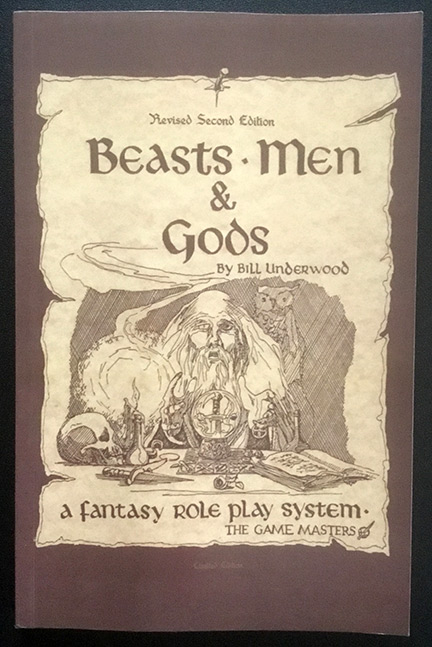


2. Ultimate Power (by Blake Mobley; published by The Game Lords in 1994)

This seems to be a more basic version of the publisher's huge Metascape game. When I say huge, I don't mean how popular it was, because I never heard of it back in the day. When I say huge, I refer to its very large box, but I'll save that one for another day. First off, if you open the book to a random page, you may mistake it for the original TORG game. Its trade dress is very similar. Even the character sheet is reminiscient of it. After learning of how this is the ultimate game tool that goes beyond any traditional RPG, we first get to the die system. You need the following dice: D6, D8, D10, and a special D16 multiplier (t, c, x1, x2, x4, x8, and x16). There are three tables: Light, Medium, and Heavy. Each roll is designated for a specific die (except the D16) and a table. You roll that die AND the D16. You then consult the appropriate table with the number rolled and the multipler rolled to get a final result. If you rolled a x16 on the D16, you get to roll it again, and multiply the original result with the new multiplier. Rolling the c on the D16 means that a lower table is used and the D16 is rolled again for a multiplier. Rolling the t on the D16 lowers the scale of the roll by one (vehicle, personal, etc.). It seems like it was their take on making a value system (like TORG/MasterBook) that could interact on all levels, albeit in a more convoluted way. I'm not sold on the mechanic, but neither am I writing it off. Our attributes are: luck, dexterity, fortitude, speed burst, strength, awareness, charisma, intelligence, will power, initiative, vitality, movement rate, and carrying capacity. Apparently, you grade each attribute, skill, power, etc. as desired, as poor, low, average, good, high, or extreme. These cost points that are calculated after the fact. When it's all said and done, you can convert the grade to a rating (the die rolled and table) and a value (such as for movement). As I mentioned, this is the basic version of rules. It's not really my thing.




3. WindZone (by Michael Paul Simon and Alan Jay Payne Jr.; published by Final Level Games in 2003)

I'm hoping this one is a bit more straight-forward. The world is flat. There's no sun, moon, or stars. Just the wind. It brings light and everything else. After a brief description of the world, we are faced with the basic rules. There are three types of die rolls: D%, XD10, and 1DX (max is X, with the numbers repeating up to X on a d10). Now we get to the races. There's a mix of flying species, humanoids, amd felinoids. There are six primary statistics (0 to 30): speed, dexterity, strength, intuition, intelligence, and wind affinity. There are huge tables for for flight, secondary statistics, etc. Skills come in levels, and each race has a package of skills. Note that wind is the mystical element in this game, allowing for special powers. Tap into the wind and you can do special things. I like that concept. Let's see how the actual mechanics are. You add 10 per skill level to the appropriate statistic (they changed it to ability score here -- I hate that, as I need consistency). That becomes the D% target number. Harder technical skills would add less if the technology is of a higher level. Combat is similar, with the opponent able to make a defense roll. The rest of the book consists of powers, weapons, vehicles, rules for survival, and descriptions of the people and creatures of the world. I bet this would have done really well if it was released as a d20 setting. The author is still selling this as a PDF for those who wish to check it out.

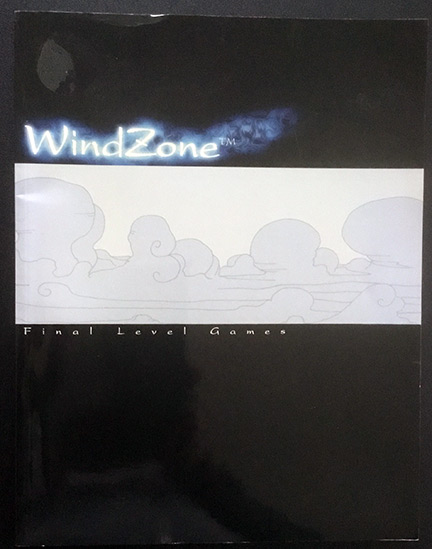


4. Man to Man (by Steve Jackson; published by Steve Jackson Games in 1985)

I'm sure most of you have heard of GURPS, but have you heard of this preview of GURPS? Man to Man is essentially the basic character creation and combat system from GURPS for fantasy games. Put another way, it's advanced Fantasy Trip. It is put together nicely with the basic instructions for creating [original GURPS]-compatible characters. Since GURPS is very well-known, I am not going into detail on this. Similar to The Fantasy Trip, it also includes some blank and terrain-filled hex sheets, flat counters, and sample characters to start battling it out. There are a number of reference sheets and more advanced rules. This would have been a fantastic purchase back in the day, even with a full version of GURPS around. To go further, I would say that an updated print version would be great for those wanting a leaner introduction to modern GURPS. You can still get this in PDF format.

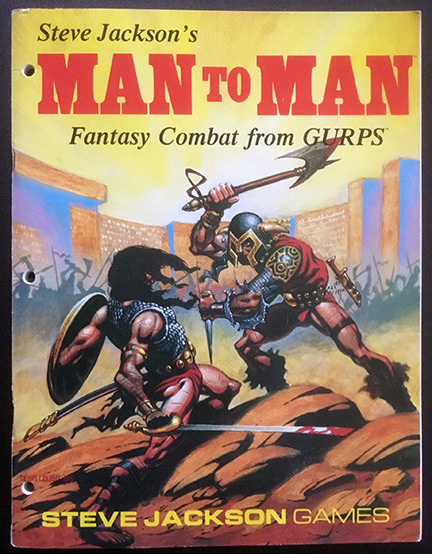


5. MACH: The First Colony (by Michael Lange; published by Alliance Publications in 1982)

This boxed set is about soldiers of fortune in a New World, or so it claims. The type is realllly small, making it all flow together. The Earth was about to be caught in a blast from a supernova. A benevolent race of aliens, also trying to save their world, approached the humans about transporting them to another world. The stipulation was that it had to be shared with some other races and they would not be able to bring guns and such. Some did. The various cultures changed behaviors, some violently, others remaining peaceful. There is also evidence of ancient, native civilizations with old cities ripe for plunder. That's the gist. Character creation concerns itself with race, age, height, weight, and nine characteristics: intellect, psyche, will, strength, stamina, dexterity, speed, charisma, and appearance. The general scale for characteristics is 3 to 18+, with the race and gender determining what to roll to determine the rating. The characteristics provide modifiers for various rolls, similar to D&D, but as percentages. Various backgrounds and profressions round out the character's skills and equipment. Notably odd is that skills are not discussed until the second booklet. We've still got to get through the rules on creating colonies, followed by combat and equipment. For combat, a d8 and d20 are rolled. The d8 determines the location hit, while the d20 determines success by having to roll over the armor class. I'm not getting into armor class. It's confusing, but kind of makes sense. I think I need to play it out to wrap my head around it. Skills are purchased in blocks, which essentially determines their odds of success. There's a nice section about life forms and some appendices with special rules. The psychic powers seem pretty good too. The third book consists of an adventure, which also includes an example of character creation, with the author even suggesting that it is more complex than in other games. I like the game's concept. And while it could easily be done with any system, there were not that many back then and certainly no open ones.

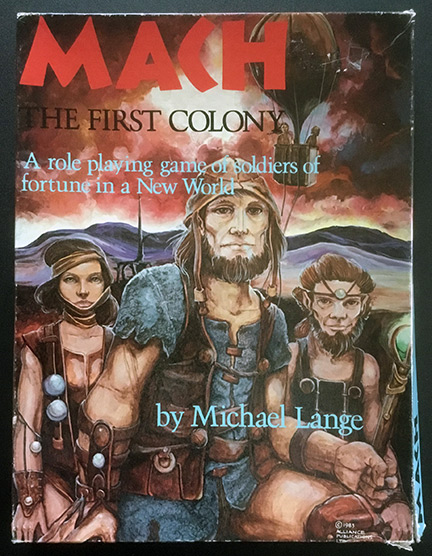


6. The Valley of the Pharaohs (by Matthew Balent; published by Palladium Books in 1983)

I am particularly fond of this game, though its text is tiny. The 50-page book is also a smaller size than most, perhaps 6x9 inches in a full-sized box. Characters belong to a caste that provide possible occupations, attribute bonuses, and skills: nobility, clergy, bureaucracy, and commons. There are five attributes determined by 3d6: strength, speed, intellect, power, and persona. The occupations, such as soldier or thief, provide skills at particular ratings (formulas are provided based on attributes). Combat is handled with a d20 roll plus any attribute bonuses, rolling over the target's armor resistance factor (this is essentially the same as D&D, but without all the tables and with AAC). There are limited magic spells, but they fit the setting, and they are cast by rolling under the spell's difficulty. I could not figure out how to handle skill rolls. The introduction talks about d20 and d% rolls, as well as roll over or under saves, but I can't seem to find the section that specifies what is rolled for skills, other than it saying "roll against the skill." I take this to mean roll under on d20, but I'm not sure. Section 2 is also about Acient Egypt. It's brief, but packed with useful information and great retro-style art. There's information on the clergy and the various gods. Just enough to get you started. The very end provides a selection of animals and monsters, as well as gamemastering notes and random tables. A loose collection of folded sheets provide a number of maps and building plans. Finally, there's a basic poster map of Egypt. This is another old game available again in PDF format.




I'll be compiling another list of forgotten games soon. In the meantime, check out something intriguing like Timeship or Exiled in Eris.


Part 9... | | 3 Comments | Add Comment | Permanent Link | See All Posts Tagged as "ForgottenGames" | | Read more... | |
This is part 9 in a series discussing forgotten RPGs (also see Part 1, Part 2, Part 3, Part 4, Part 5, Part 6, Part 7, and Part 8). That is, games most people have never heard of or that didn't last long on store shelves for one reason or another. This is another batch of sci-fi type games. Most of these games have been sitting on my shelf for years, mostly ebay finds to add to my collection.


1. Xenoforce (by Simon Parkinson; reproduced by Dragon Games in 1997?)

This spiral-bound game starts out with a full-color comic. I'm not generally a fan of that in an RPG, unless it's that sort of RPG. I don't think this is. The introduction touches on the setting, explaining the alien cover-up in Roswell and that Xenoforce was created as a worldwide agency to deal with such issues. Various branches and relations are discussed. After the usual talk of dice and record-keeping, we move onto characters. There are five abilities that max out at 90: strength, perception, constitution, agility, and influence. There are various methods for determining these values. Then we move on to major and minor skills, the former being expertise (base rating of 65) and the latter representing some knowledge (base rating of 40). Abilities also modify these values as per a chart, from -5 to +6 for major skills and -7 to +5 for minor skills. If you don't fill all the available skill slots, you get bonuses to the others. Using a skill is just a percentage roll for the skill rating. Combat works similarly, modifying the chances for range and cover, for example. There are special rules for grenades, automatic fire, falling, etc. I don't think it's as expansive as Bureau 13, but gets the job done. We finish off with information on aliens and a FAQ. The character sheet seems to be really well organized, allowing you to fill in all the needed numbers. There's also some reference sheets in the back. This is another game that doesn't offer anything for me today, but I probably would have tried it in the early 90s if it was around (it was not).




2. Twilight Imperium: The Role-Playing Game (by Todd Nilson, Jason S. Williams, and Darrell Hardy; published by Fantasy Flight Games in 1999)

While the Twilight Imperium boardgame has been very popular, I'm not sure the RPG was well-known, nor do I think it lasted long. Obviously, this takes place in the setting of the boardgame, so we are introduced to that in the beginning of the book, including various worlds and the species. That brings us to page 45 for character creation. The steps are clearly laid out. Characters have five personal statistics (1-20): body, ability, mind, education, and charisma. Skills are rated from 1 to 60, with points allocated depending on profession. Why is there an entire space between the skills for each profression? It spreads them out over too many columns and pages. Skill rolls are percentage-based, rolling under personal statistic plus skill rating. I'm not a fan of the combat system. Your attack roll is exactly the same as a skill roll. There is no opposing effect. Of course, you can always dodge, but that too is just a skill roll and it avoids all future attacks during the same turn. There are options to adjust combat percentages for range and cover, but that's about it. After this, the book moves onto discussing technology, weapons, and the more exotic stuff. Space travel and combat is next, following the same basic rules. The book is rounded out with a gamemaster's guide and sample adventure. When it comes down to it, this is a rather simple game for playing in the Twilight Imperium setting. I'm not sold on it though. It seems to be a child of the 90s in its simplicity, but to me, it fails to deliver on what could be an incredible gaming experience. It's also rather interesting to compare this game (and its system) to the publisher's current lineup of RPGs. They seem to be on opposite ends of the spectrum. Whether that's good or bad is for the reader to decide.




3. Star Riders (by Hans Guévin; published by Ianus Games in 1993)

This is billed as "a wild space opera comedy game" and compatible with R. Talsorian Games' Teenagers from Outer Space. Players portray Star Riders, which are sort of like hippies and bums in space. There's eight stats (1-6): smarts, bod, relationship with pals, luck, driving, looks, cool, and bonk (number of hits you can take). There's also knacks and powers. Doing things means rolling 1d6 and adding your relevant stat. Higher results win. That's it. The book discusses the setting, aliens, equipment, and wild stories (lots of scenarios). If you're looking for something less than serious, simple, and with lots of ideas for play, this is probably for you. It should be noted that Ianus Games is now Dream Pod 9, and Star Riders is available as a downloadable PDF.


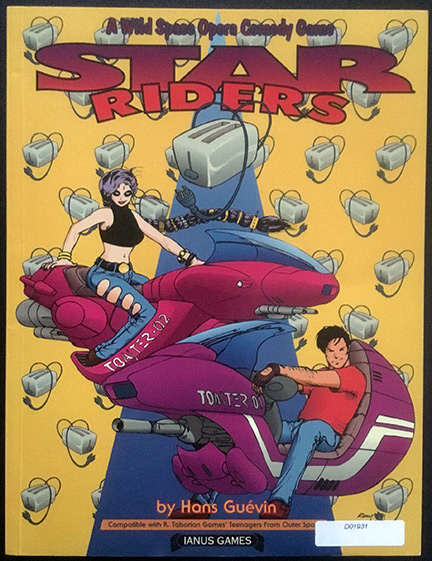


4. Danger Quest (by David Matalon; published by Torchlight Games in 2002)

This is a pulp RPG set in the future. After a brief description the setting, heroes are explained. There are nine basic attributes, three physical, three personal, and three martial: brawn, moves, reflexes, brains, charm, nerve, sense, marks, and fight. There are two methods for determining these values, either 2d10+20 for each or allocating 260 points for a rating of 15 to 40 for each. There are also calculated special attributes and abilities (special bonuses). Various childhood tales help round out the character with a variety of bonuses and gear. There are also motivations, secrets, weaknesses, and vocations. Finally, we also get building (bonus) points for adding even more oomph to characters. We're faced with a lot of numbers when filling out the character sheet. Fortunately, they are mostly consistent and easy to understand. Skill rolls are roll-under percentages (the skill value being based on an attribute, plus any bonuses added to it; halve the attribute when unskilled). Here's the twist. Skills can also have levels beyond the basic. And each level allows a character to add 1d10 to his skill roll per round. Not only that, these skill dice, as they are called, can also affect other rolls affecting the character, such as someone shooting at him. This can turn into a bidding war by increasing the extra dice rolled until there are no more in his pool. Combat seems to work the same way. There's lots of rules for combat, building things, and magical ways. Then there's lots of info in what is basically a GM's section, including rules, NPCs, bestiary, advice, and so on. More detail on the setting and a sample adventure also follow. This seems like a solid game, but nothing in the setting really grabbed me. Others may take to it. I think there are some unnecessary complexities, but they can probably be ignored.

My obligatory shill circuit just lit up, so I can't skip to the next entry without telling you to check out Two-Fisted Tales, which is Precis Intermedia's RPG of thrilling pulp action. It has it all: gadgets, mystical arts, magic spells, hypnotic disciplines, and even Golden Age superpowers. If you're into pulp action, this game is for you.





5. Orbit (by Jeff Diamond; self-published in 2003)

From reading the introduction, characters begin a four-year "wandershen" to explore and grow in a universe full of spaghetti western and b-movie tropes with a splash of humor and music videos. Characters come from various civilizations of the free league. There are a bunch, including those akin to cat people, dwarves, lizard people, tree people, and more. There's a bunch of background tables and you get to choose a homeworld. The real meat of character creation begins on page 46. There are five stats (rated 3 to 30): body (life), agility, tech, wit, and health. There are also traits, quirks, and careers. I was not expecting the full-page color art inside. There are four skill levels, each being a multiplier for the relevant stat when making a skill roll: x1, x1.5, x2, and x3 (unskilled being x0.5). This means that a skill roll involves a d% roll under the stat times skill level. Combat rules start on page 145. This is needlessly long. Combat works similarly. An opponent can defend, reducing the attacker's degree of success (difference between what is needed and rolled). Starship rules are also included, but there is a lot of reading required for this book. Page 170 brings us a brief history of the galaxy, followed by GM info and setting material. I feel that there is just too much information in this book, so I can't really get into it. That said, if it had a simpler rules presentation (like Star Riders or Foreign Element), I would probably be all over it.

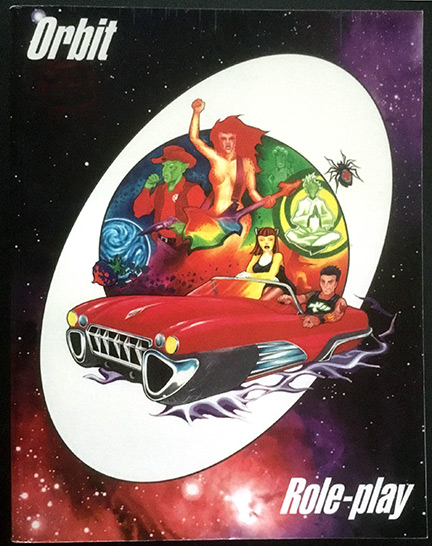


6. Zero (by Lester Smith and Steve Stone; published by Archangel Entertainment in 1997)

The characters are rebels who have been expelled from a telepathic hive. Think of it as waking up in the Matrix movie. Each character is part of a caste (or was): archivist, breeder, drone, soldier, or tech. Abilities are like skills, but separated into focus abilities (expert), prior abilities (rusty), and unfamiliar abilities (unskilled). The total number of focus abilities is the focus rating. This has an interesting mechanic. Roll 2d6, but multiply the two results. Some rolls may call for a single die to be increased or reduced in value. Roll equal to or over focus rating for focus abilities, equal to or under focus rating for prior abilities, and under focus rating for unfamiliar abilities. The explanations for the rules are hard to follow. Combat seems to rely on the same rolling mechanism, but I can't pin down an exact description for it. Maybe I'm just missing it. Fiat seems to be the theme of the rules. Page 46 begins talk about the GM's role, followed by adventure and campaign information, creatures, and a sample adventure. According to the final page, the whole game was built around the artwork. I have zero interest in playing this. No pun intended. I'm sure someone loved it at the time. Maybe lots of people. I doubt it.


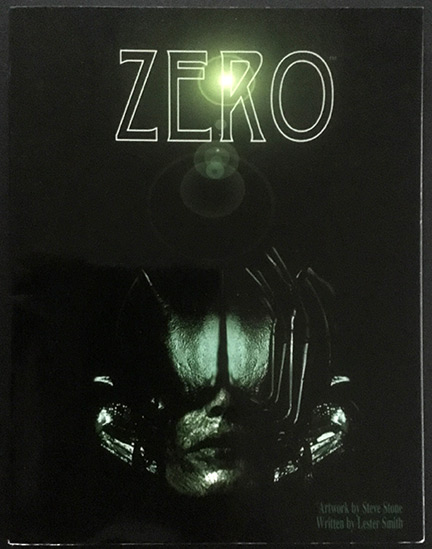


That's this list. What will be next? Stay tuned. If you'd like to help support my time-wasting, check out my latest releases and hot sellers.


Part 10... | | 0 Comments | Add Comment | Permanent Link | See All Posts Tagged as "ForgottenGames" | | Read more... | |
This is part 10 in a series discussing forgotten RPGs (also see Part 1, Part 2, Part 3, Part 4, Part 5, Part 6, Part 7, Part 8, and Part 9). That is, games most people have never heard of or that didn't last long on store shelves for one reason or another. This is another eleclectic mix. Most of these games are relatively new acquisitions, typically ebay finds to add to my collection.


1. Witch Hunt (by P. Baader and R. Buckelew; published by Stratcom Simulations Inc. in 1983)

This is an interesting game. It is designed to do one thing. Either locate and punish witches in Puritan America or escape such a gruesome death. While it is possible to go beyond those parameters, I don't see any long-term campaigns coming out of it. This is a boxed set. For the time, it is very well done. Character creation starts with physical characteristics, which are essentially age, height, weight, marital status, social status, and occupation. Then we move onto physical and mental attributes (rated 1-100): strength, constitution, speed, agility/dexterity, comeliness, wit, knowledge, intuition/premonition, wisdom, and will. As characters advance in level for their chosen aligment (magistrate or witch), certain attributes get bonuses. Some attribute tests (like strength) are performed as a D% roll under the difference between both character's rating (active character's rating - resisting character's rating = odds). Other tests use an attribute rating as the base chance, modifying it for various situations. The way a test is handled for each attribute is described, with combat working in a similar manner. One element that is generally missing from other games of this publishing era is that inanimate objects are given strength ratings to determine the odds of shattering/penetrating them. Nice touch. Weapon damage depends on the strength of the person using it (this is a wide table). The basic rules complete on page 14. The rest of the book details magistrates' duties and procedures (searching, interrogating, arresting, etc.), trials, magic (curses, familiars, etc.), and a basic GM (town crier) section. Historical notes, maps, and a sample scenario are included. I hadn't heard of this game until a few years ago. I would have picked this up back in the day if I ever saw it. It's the sort of game that sounds really cool at the store, but has limited play value. Nevertheless, I'm glad I own a copy.

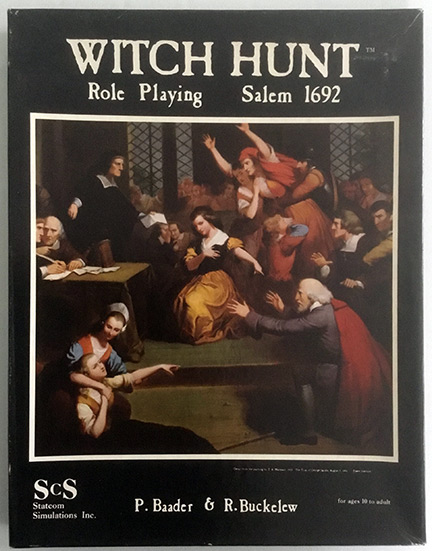


2. The Mechanoid Invasion (by Kevin Siemieda; published by Palladium Books in 1981)

This small book printed on what looks like newsprint is another interesting game. It seems to be the first published use of Palladium's RPG system in some form. We dive right into the rules without any explanation of the setting. It discusses the GM, hit points, armor rating, and a few other details before hitting up character attributes. There are eight of these, rated as 3d6 (17-18 gets a special bonus): IQ, mental endurance, mental affinity, physical strength, physical prowess, physical endurance, phsyical beauty, and speed. Next up are seven Occupational Character Classes (OCC), from pilot and engineer to commando and esper, with a few optional ones. OCCs are very much like D&D classes, with special bonuses per level to skills and weapon proficiencies. I'm stopping right here to discuss the art. It is great. It's a more serious tone than that in D&D of the time with a nice level of detail for line art. The newsprint and art combine to give it a feeling of an old mail order catalog or advert page in a comic book. Anyway, combat is easy. Roll over a target's armor class (hopefully using class bonuses). Rules for combat are minimal, but the equipment describes some special rules. A number of vehicles are included, as are creatures/enemies. Psionic-weilding characters and creatures add that extra level of fun. A brief discussion of the setting ends the book. The cover price of $3.75 would have made this an unbelievable buy back in the day. My first introduction to Palladium Books was their Robotech RPG, but I find this to be a better game for sheer size. One gripe is that the text is very small. There are two other volumes in this series. You can get the trilogy of this series here in PDF format.




3. Road Rebels (by Dale L. Gordon; self-published in 1989)

I've got a love-hate thing going on with this game. On one hand, I love the concept. You outfit your vehicles and duke it out Mad Max style in a post-apocalyptic world. The vehicle upgrades are good, but the rules kill me and there is almost a total lack of art (which is not a big deal in itself). After the basic premise is discussed, hostility on the road is the first table, followed by info on movement, combat, and using and borrowing money. The organization seems a bit off, as we move onto rolling up characters. There are seven characteristics, rated from 3 to 18 (roll 4d6, drop the lowest die): strength, dexterity, looks, constitution, size, charisma, and speed. Social classes (like peasants and road rebels) come into play in much the way classes would. There's lots of fiddly bits that really turn me off. There are three values for elements like climb rate or strike rank bonus, using the appropriate one for the character's condition level (level 2 is the default). Weapons have a quarter-page specifications sheet -- it's a bit overwhelming. Skills are discussed as being a d% roll, but you get bonuses depending on particular characteristic ratings. One element I find interesting is that weapons use a cutting class (A to J), which is used on a table to determine armor penetration. Page 49 introduces equipment, while page 77 rolls out the vehicles. Each one gets a two-page sheet of form information. The layout is so simple that it makes digesting it very tough. This goes on until page 117, where vehicle-related rules are discussed. We get creatures starting on page 157. At least, these are easy to read, except that the damage values for their weapons take up a lot of room. A very short sample scenario and reference sheets finish the book. I'm worn out. I see where they were going with the rules, but between the presentation and amount of things to track, it's not my cup of tea. Other than some weapons and creatures, there's also not much to mine here for other games.

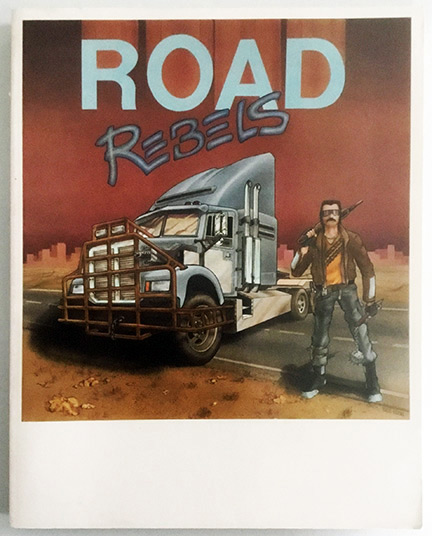


4. Mars (by David Tennes; published by FASA in 1981)

This book is a little different from the others in that while it does consist of a rules system, it is more like a sourcebook for other RPGs or generic system for your own miniatures/roleplaying settings. It's primarily about combat, but it does allow for knowledge-based rolls. Every rule is numbered, making it both easy to reference and hard to read at the same time. There are five characteristics rated as a percentage: strength, dexerity, agility, endurance, and intelligence. Combat factors are used to determine base odds for a given attack, typically being averages of certain characteristics; these are: unararmed, armed, and projectile (there are two of these for different levels of stress). Each character also has a damage points rating to track injuries. Certain bonuses are also possible, such as for martial artists and non-human species. A number of animals are listed with damage points, natural weapons, and the damage they do. The rest of the book details movement, sighting, surveillance, communication, hit modifiers, and all other aspects of combat. It is what it claims to be, nothing more and nothing less: a solid system for handling combat that can be used with your own settings, another RPG, or with miniatures. For example, don't like your existing miniatures rules, use this book instead.




5. Challengers (by David F. Nalle; published by Ragnarok Enterprises in 1985)

Another book with very small, computer-type text, which makes it hard to read. I can't really fault it for the time, though. This is a superhero game. Does it work well as one? Let's find out. There are twelve characteristics divided into physical, active, mental, and social categories, and rated from 1 to 20: size, constitution, strength, reaction, dexterity, agility, psychic ability, rationality, education, appearance, charisma, and social status. That's a lot. As long as there are no skills, I'd be OK with it. Secondary characteristics are calculated: hand attack, missile attack, hand defense, missile defense, attack force, activity points, hit points, fatigue points, training points, movement, and initial wealth. Makes it easier to handle rolls if they are all calculated beforehand. Makes sense. Uh oh. Skills and training mean more numbers. Doesn't seem too bad though. Training points buy skill ratings. Skill rolls are handled with a D%, using a chart that I have to look for several pages later. It baffles me. The odds depend on the characteristic rating and skill rating, but without an example at this point, I am very confused. I also stumbled on the skill list. There's a lot, and each has a different cost in training points per level. Combat is up next, which doesn't seem too difficult. Roll D%, adding appropriate attack rating and subtracting defense rating, and then consulting the appropriate attack chart. I only see one chart, but the column used depends on the desired hit location or area covered. I'm starting to feel like I'm on a merry-go-round and I want to get off. Let's see what else we've got here. I had to back up to find the powers. There's a fair number, each with its own special rules. I'm not sure how complete they are. Vehicles finish this book. The second book consists of background, adventures, and several characters, which could easily be mined for use with other superhero games. The cover claims "unique superhero adventuring," and they are certainly not wrong. It's not my thing, as the system is way too complicated, especially for a superhero game. The D% roll could have been handled in a much simpler way, and I am not fond of that many characteristics. I feel bad, but I guess the $1 price tag on it (for a $9.95 cover price) should have been an indication.

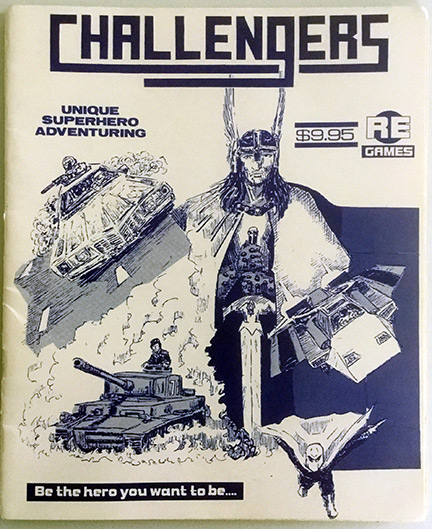


6. Hunter Planet (by David Bruggeman; published by HPAC (Australia) Pty. Ltd. in 1985/1987)

This is the second edition that came in a red folder, containing an adventure, blank sheets, and some other material. What is the game about, you ask? It's basically about going on an alien safari. You hunt dowm creatures on an alien planet. Quite a unique premise, as that is pretty much all the game is about. Sure, you can do other things with it, but I'm not sure what. After a history of the empire of man, the first piece of art confirms that this game does not take itself too seriously. It's about fun. More specifically, it's about the fun of going about and killing things on a hunt. Make of that what you will. Rule Number 1 is that if you don't like the rules, don't use them. Fair enough. The rest of the rules start with explaining character creation. There are seven characteristics rated from 1 to 10: strength, dexterity, charisma, intelligence, constitution, general knowledge, and luck (1-6). That's it, other than personal details and equipment. I like it so far. Nice and easy. The rules (still on the same page) then explain the effects of certain weapons, survival, and equipment. A sample chracter, X Bear (which looks like a teddy bear, even to scale), is provided. Then we get the GM's rules, which actually explain how to fight. There is a base 50% chance of hitting something, modified by however you want. At this point, I do not see any relevance to characteristic ratings. Luck can help a character by making a d10 roll under its rating, but the effect is up to the GM. I also found actual combat modifiers later in the book. There is a quick reference to making a roll against a characteristic for actions outside of the normal range, so I assume this is also d10 roll under, although it also states an arbitrary percentage roll can also be made. This leads me to believe that characteristics are not at all important. Maybe I'm missing something. I'm not going to touch on the adventure, but other than the possibility of it being useful in other games, I don't really see much here to recommend.

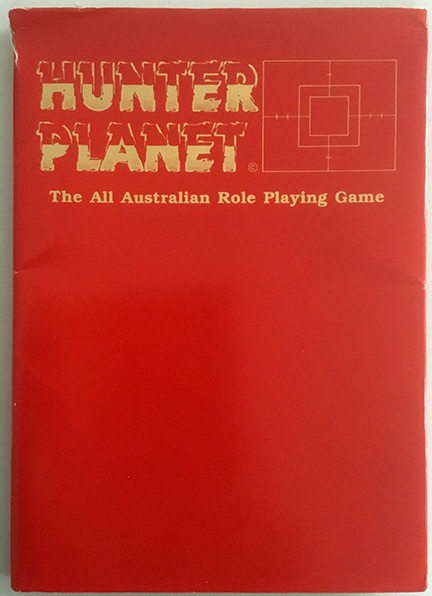


That's another list in this series done. If you're looking for more nostalgia, check out the Wee Warriors line of Dungeon Kits and boardgames from 1976-1978, available once again. And coming back into print soon is Worlds Beyond, a space action RPG from 1989


Part 11... | | 0 Comments | Add Comment | Permanent Link | See All Posts Tagged as "ForgottenGames" | | Read more... | |
This is part 11 in a series discussing forgotten RPGs (also see Part 1, Part 2, Part 3, Part 4, Part 5, Part 6, Part 7, Part 8, Part 9, and Part 10). That is, games most people have never heard of or that didn't last long on store shelves for one reason or another. This is another eclectic mix, but I included two for the Halloween season.


1. Night of the Ninja (by Tom Wall and Sandford Tuey; published by IIE Games Corporation in 1986)

Yes, you play a modern-day ninja. I'm not sure there's much more than that here. We are first met with character information. Every ninja gets Survival Points, which are essentially hit points, and they increase when a character goes up in level. Next we have Conscious Points, which is what it sounds like -- a measure to determine when a character loses consciousness due to things like to knockout gas and electric shocks. Then we are introduced to what is called Physical and Intellectual, which represent experience in certain areas. They are tracked separately, and both must meet certain thresholds in order for the character to increase in level. Abilities are rated on a scale from 10 to 50: Strength, Agility, Co-ordination, Stamina, Mental Discipline, Knowledge, and Pre-Science. There is also an Aggregate Score, which is the average of all abilities, and used when there is no clear abilitiy for a dice roll. A list of skills fall under Knowledge, and generally use that ability for dice rolls. Rounding out characters is done by determining values for Hearing/Listening and Vision. Even though we have already made dice rolls at this point, dice are finally discussed now. The two-page chaacter sheet has all the essentials and is a nice break from the busy sheets belonging to many of the past games in this blog series. Turn sequence and movement is fairly typical, with the nice addition of stamina rolls to maintain pace. Striking is level-based in that each side rolls 1d10, with the higher roll damaging the other, and the higher level gets the difference in levels as a bonus to both the roll and damage. As would be expected for ninjas, there are special rules for "move silent," dodging, climbing, falling, swimming, surprise, leaping attacks, strike to subdue, and structural damage. Weapons and special rules for them bring modifiers to rolls and damage, and may require a minimum level for use. The Ninja Master Section is about 3.25 pages, followed by a few pages about Ninjitsu. An adventure moduled, called Enrage the Night, is advertised in the back. I wonder if they ever released it. I'm not sure this is anything I would ever play. The rules seem servicable enough, but maybe incorporating some ideas into your favorite RPG would work better.


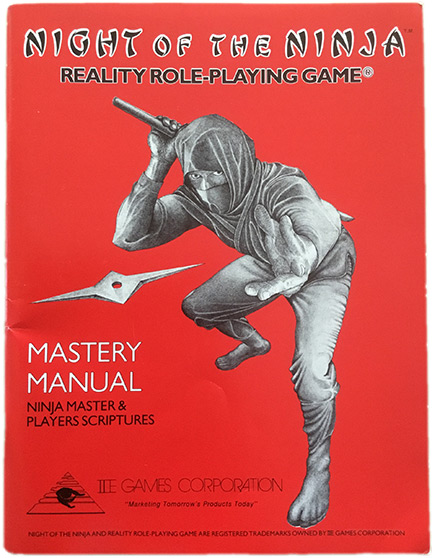


2. Time Drifters (by Zinny Brown and James K Shepard; published by Dimensional Strategies, inc. in 1990)

One would expect this game to be about time travel. The introduction states that time Drifters "combines the excitement of science fiction with the harsh realities of the past and incredible adventures of the future." Does it? The game uses both d10s and d6s. First stop is character creation. There are six abilities, rated by rolling 2d6+6: Might, Smarts, Quickness, Accuracy, Bravery, and Looks. Curiously, some get a bonus percentile if an 18 is rolled (not sure how this is applied yet). Certain modifiers apply for abilities and their ratings, such as damage, intiative, and accuracy. The basic mechanic is that a D% (called 2d10) roll is made, with that value referenced across the top of the Action Results Table (a small but nifty Time Master's Screen is included, and I don't think it's incorporated into the main book at all). That column is then compared to the row with the ability's rating to determine a color-coded result. It's similar to how Pacesetter's Action Table works. Anyway, after that is explained, we're back to character creation. Various types of characters (like Indians or Gunfighters) provide different modifiers and effects. They are essentially classes. We've got hit points and status levels, the latter being similar to D&D class levels. Equipment, common rules, talents (advantages), and a sample adventure round out this 78-page book. There's nothing really here involving science fiction or time travel. It's a Western, clearly planned to be the first genre in a series, but it seems like the only release. Is it any good? The system is relatively easy, feeling like a cross between old D&D and a Pacesetter game (Star Ace, Chill 1E, or Timemaster). I'm actually feeling the urge to play around with it a bit.


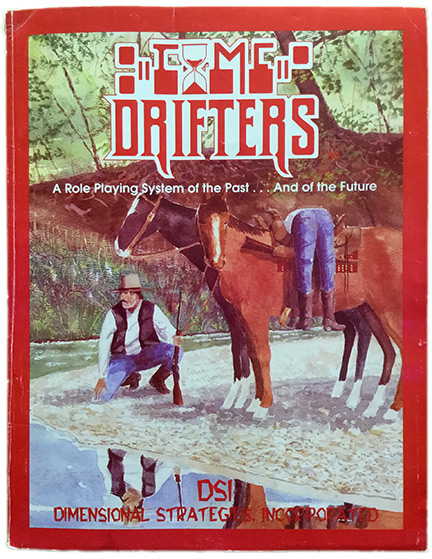


3. It Came from the Late, Late, Late Show (by Bradley K. McDevitt; published by Stellar Games in 1989)

There are a few versions of this in circulation. The one I am discussing has the cover shown. This game is different from most in that the players portray actors in a movie, typically about surviving aliens, zombies, and monsters. The introduction provides a lot of useful information, such about needing ten-sided dice, most rolls being D% roll under ability, and how to act appropriately stupid. Characters have 5 basic abilities, rated by rolling 4d10 for each: Build, Dexterity, Brains, Looks, and Fame. Survival Points are like Hit Points, equal to Build plus Fame. The final step is to make 20 1d10 rolls to place points into 20 Talents, such as unarmed combat or singing. Conflicts occur during Frames (a 10-second turn), Takes (6 Frames and a time for refresh), and Reels (60 Takes and also a time for refresh). Common rules are included, such as for various forms of movement, surprise, and fear. Interestingly, someone with 0 Survival Points must act like he is unconscious and dying until restored or at the negative equivalent of his starting value, at which time he is written out of the movie. There are other such rules akin to movie terminology, such as commercial breaks and walking off the set. Props are essentially special gear, as is wardobe. Page 26 begins the Director's Section. Lots of good information for maintaining the theme of being in a movie. Next up is about creating monsters, followed by a catalog of monsters and then extras that have no stats. That's it. Short but sweet. I think it works, but I feel that it is a very niche product. There were also a few supplements to expand the game.


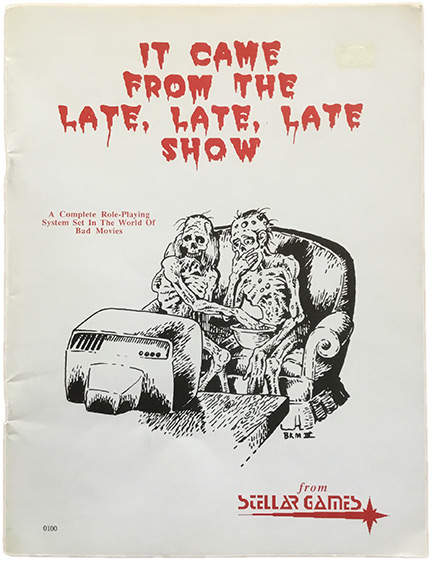


4. Don't Look Back: Terror is Never Far behind (by Chuck McGrew; published by Mind Ventures in 1994)

First Impression. Boring layout of the time. I'm not saying it's a bad thing, but it lacks atmosphere and kind of dampers my excitement of digging into it. We'll skip to page 17 for characters, but note that six-sided dice are used. Characters have 6 basic abilities, rated from -5 to +5: Fitness, Dexterity, Intelligence, Perception, Will, and Social. Acquired abilities are also a thing, but these seem to essentially be skills. There are also advantages and disadvantages. My thought here is that it is a modern system, vastly different from all those D&D holdovers. Adding to acquired abilities, they work as one would think, as bonuses to their relevant basic abilities. There are various types of characters, used as guides, including Gung Ho Military Types, Secret Agents, Techno-Nerds, Investigators, Scholars, Slackers, Big Dumb Jocks, Colleg Students, and Clergy. Action resolution involves adding up the ability rating and various modifiers, such as difficulties. This absolute value is the number of dice to roll. If it's a negative number, keep the three lowest dice; if it's a positive value, keep the three highest dice. Then compare the total to a chart to determine the level of success. The total must be 11 or higher for success (it is a constant baseline for succeeding). A quality is also attached to success, acting as a ± modifier to certain actions, such as damage. Page 71 begins Book 2, which is for creating adventures and contains information on the setting and paranormal. Two sample adventures follow, along with an appendix of useful chart and tables. A newer version seems to be available from Retro Roleplayer.


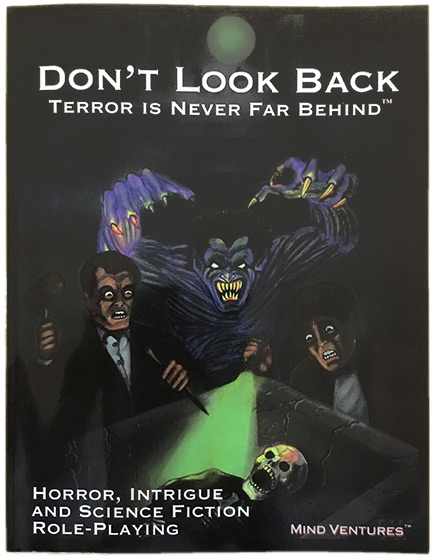


5. The Arcanum (by Stephan Michael Sechi and Vernie Taylor; published by Bard Games in 1985)

This is the second edition of what was part of The Atlantean Trilogy, and originated from material in The Compleat Adventurer, The Compleat Spell Caster, and The Compleat Alchemist -- all products designed to expand D&D. This is a densely-packed book with small type, but it is easy to read and fairly well-organized. I am going to skip over most of this, because it is essentially an offshoot of D&D. And I think it's fair to say that this is the precursor to Talislanta. Several races and LOTS of classes are provided, with what you would expect from a D&D race/class. There are 8 attributes that range from 5 to about 25, but capped by a racial maximum (typically fom 14 to 19): Intelligence, Will, Perception, Charisma, Strength, Dexterity, Constitution, and Speed. There are also skills, with effects ranging from modifiers to D% rolls. Unlike D&D, armor reduces damage (something that Swords & Six-Siders does too). There's a variety of magic styles, potions, items, spirits, etc. from pages 62 to 148. In fact, there are only two chapters, Character Creation and Magic. The appendix provides tables of weapons, supplies, and herbs, plus miscellaneous rules and sheets. There is a lot of content here and a good portion can probably be ported over pretty easily to D&D and OSR materials. A 30th Anniversary Edition is available from ZiLa Games.


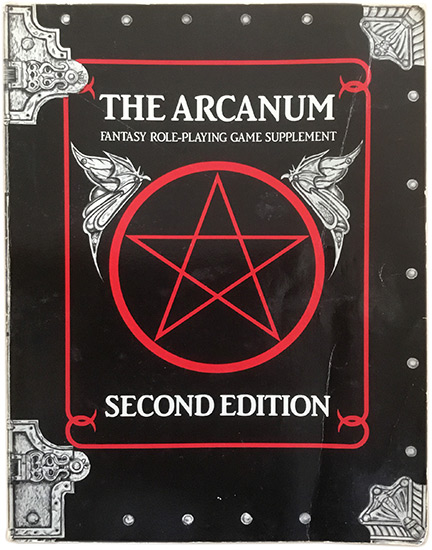


6. Holocaustic Dungeons (by Kristoffer A. Silver; published by Silver Wolf Games in 1986)

This is a rather unusual game. It is essentially a rules-lite, quick dungeon crawler. There are 5 basic attributes: Strength, Dexterity, Constitution, Fighting Ability, and Intelligence. I don't see any minimum or maximum values listed, so I assume that there are none. Then there are Hit Points and Nourishment, the latter used to track food and water. Weapon Ability is determined with a D% roll for each weapon the character knows how to use, which is determined by his Fighting Ability rating. Shield Ability counts as a weapon when it comes to Weapon Ability. Experience and Construction points are gained and used during play to increase Weapon/Shield Ability or basic attributes, respectively. Page 8 begins a list of weapons and armor. The bulk of action starts on page 13, as it explains the hex system in which dungeons are described and then the battle sequence. This works well as a solo game, since opponents act in a certain way. For example, they always use the most-powerful long-range weapons. If they don't have one, then they use the most-powerful medium range weapon. If he has a weapon that does more damage at the current range, regardless of maximum range, that gets used. You get the idea. Close combat rolls are actually similar to a project I am working on (Labyrinthine Adventures™, a new edition of Wee Warrior's Labyrinthine™). The percentile target is 50 + attacker's ability - defender's ability. Ranged combat is a bit trickier, being the attacker's ability with the weapon decreased by the amount of the defender's Dexterity over 10 or increased by it under 10. The real interesting part is the descriptions of rooms. Different types of rooms you can enter produce different effects, such as increasing attributes or adding a new friendly character. There are tables for adding random characters, signs present in rooms, weapons, treasures, and dangers. All in all, this is a neat little game, though it's primarily for exploring dungeons and fighting. The basic rules are complemented with several dungeon level books. While there are no maps per se, dungeons consist of a list of numbered rooms for use on a hexmap.

UPDATE: Holocaustic Dungeons is now part of the Precis Intermedia family of games.

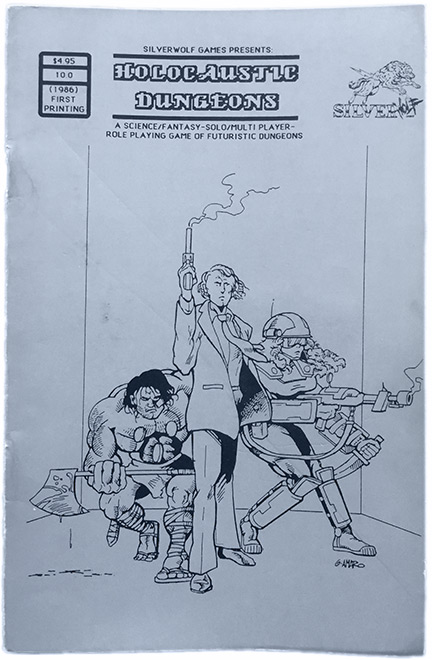


Number 11? That's quite a few Forgotten Games so far. Some on this batch should be just as forgotten as the others. Talking about old stuff, be sure to check out the new printing of Rune Stryders, the Fantasy-Mecha RPG and also The Misty Isles for Swords & Six-Siders (the original 1977 Wee Warriors Dungeon Kit updated for 1d6-based OSR gaming).


Part 12... | | 0 Comments | Add Comment | Permanent Link | See All Posts Tagged as "ForgottenGames" | | Read more... | |
This is part 12 in a series discussing forgotten RPGs (also see Part 1, Part 2, Part 3, Part 4, Part 5, Part 6, Part 7, Part 8, Part 9, Part 10, and Part 11). That is, games most people have never heard of or that didn't last long on store shelves for one reason or another. This entry consists of a mix of fantasy titles.


1. Dragonroar (by Peter O'Toole and Allan Paul; published by Standard Games in 1985)

This boxed set is designed for beginners, so that is how I approach it. It comes with a rulebook, arrangeable floorplans, flat counters, blank character sheets, reference sheets, and a cassette tape. Yes, a double-sided cassette tape introduces you to the rules. I have not listened to it, so I won't comment on that aspect, but it was a novel idea back in the day. Onto the the 45-page rulebook. It's nice for the time. Not full-color, but the purple and black ink really helps highlight and differentiate bits. We start with one page of setting info. Not much, but enough to get started. Then the obligatory "What is Role Playing?" section, following by a description of the Arbiter (the player captain, as it were, who speaks for the group) and the Fatemaster (gamemaster). Next up is character creation. This game uses 9 Life Levels, which seem to increase by Honour Points rather than XP. Life Level reduces damage from attacks, increases chance to hit, and increases spell-casting odds. There are two professions: warriors and wizards. There are five characteristics, each derived by rolling 4d6 and totaling the two highest values: Strength, Speed, Willpower, Knowledge, and Endurance. There are five fields of Knowledge which provide various odds for "out of field," "in field," "specialization," and "expertise" based on that characteristic's rating. These also determine the number of spells in certain fields. As with D&D, characteristics can provide modifiers for certain rolls. There's info on traveling speed and rest, placement in squares, sights and sound, and then combat. Most rolls are percentage-based and combat is no different. Weapons give you the base odds and damage, modified by characteristics and level. Sound familiar? Hit location plays a factor, much like RuneQuest, with each race having unique hit charts. Specialized rules include concussion, morale, and minimal magic. There seems to be very little in the way of treasure, magical or otherwise. There are about 12 creatures provided, including the war hedgehog, killer penguin, and manelephant. Nice. A starter adventure rounds out the book. The upshot is that while there is not much here for long campaigns, it is definitely enough to get you started with functional rules. In fact, it would be very easy to expand the list of knowledges and rules yourself. Thumbs up for what this sets out to do. I should also mention that both the art and layout are good, which adds to the assessment. As a British game, I don't think this made it to the US back in the day, or at least not in numbers, which is a shame.





2. NeverWorld (by Erin Laughlin; published by ForEverWorld Books in 1996)

Another boxed set, this includes a rulebook, culture book, GM screen, 2 ten-sided dice, and a few other bits. It's billed as the only true fantasy game. A bold claim to be sure. I'm not even going to try to prove or disprove it, because who cares? The question is whether or not it is a good game. The rulebook is almost 300 pages. Rather large for a boxed set. It starts with the usual basics and then an introduction. Ah, fleshing out characters is what I want. There are 7 possible PC races: Beastish (humanoid animals), Dwarves, Elves, Giants, Grobbers (orcs, goblins, etc.), Humans, and Metamorphouns ("sneaky" shape-changers). Then there are cultures, but it's not explained yet how to choose that. Age has an effect on characters. It looks like Advantages are like attributes, but only in that they are above the norm. There are also Disadvantages, seemingly acting like detrimental attributes, so this is a little confusing. These are broken down into Physical, Mental, and Social, appearing to be rated from 1 to 10. We're already discussing skill modifiers, but I have no idea how to make skill rolls. And if an advantage in Strength determines lift increase, does a disadvantage at the same level apply the same penalty to lift? I'm already losing interest. I'm looking at tables for required Perserverance levels, required Confidence levels, and logic modifiers. It's rather overwhelming. Skipping ahead, there's info on careers, one being the Adventurer. It lays out certain elements, like masteries, pathways, advantages required, income, equipment, assets, and prerequisites. Seems to be an interesting take on classes and such. There's lots of info on friends, patrons, rumors, etc. Chapter 41 starts the conflict rules, or the "ROC -n- roll" system. Unobstructed actions do not need a roll if the character has a base value of 60 or more. However, he can choose to roll for greater success, the base being "D." Not sure what a D success is, but to be fair, I might have skipped over it. Other types of actions require a roll. Here's the odd thing. I thought it was a straight percentage roll. It's not. Roll d100 and add the character's base, which is his skill rating minus difficulty. The difficulty is generally double the skill complexity, but could be 3, 4, or 5 times it, depending on the GM's assessment. The ROC (Rolling Outcome Chart) table is then consulted. For example, a roll of 60 is a D success, which is like a solid success. A roll of 200+ is an H success, representing an inconceivable success. I'm skipping the rest, because it's a lot of discussion on special rules, like masteries in subterfuge, drama, and leadership. Then there's Metaphysics starting on page 135. Yes, that's how far we've skipped. Chapter 6 on page 209 discusses building your world, which includes lots of creatures and treasure. The rulebook ends with fiction, a character sheet, and worksheets. I don't think I've ever seen fiction at the end of a book. The second book is a culture book for the Hourani, which are a Metamorphoun race. It details using them as characters, lots of careers, religion, wizardry, and locales. It looks like a flood of information that could prove useful, but unfortunately, this game is just overloaded with content. If I had to compare it to another game, I'd say Gary Gygax's Dangerous Journeys, which is too much text all at once.


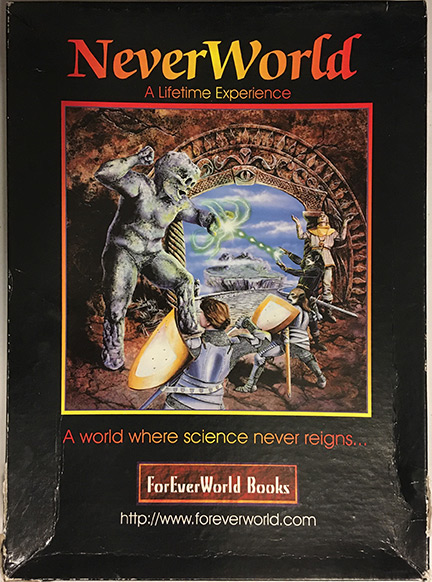


3. Ironworld (by John Brooke; published by Empire Wargames in 1989; previous versions go back as far as 1979)

This small boxed set is hard to explain. It includes a number of small six-sided dice, two identical rulebooks, lots of index cards, and a map divider (I guess it's like a GM's screen). Everything is small. Too small. The printing is color, but early 80s low-res dot matrix, making it hard to read. The first two pages introduce the world. The first line after that says that "Ironhedge is a quantum role playing game of fighting, magic, power, and treasure." Note that Ironworld seems to be the boxed set version of Ironhedge. Interestingly, the game uses polyhedral dice, even though it only includes d6. All the elements are presented, such as Attack level, Life Points, Inherent Abilities, etc. It's cramped. Very cramped. We're discussing rolls and such, and thief functions (such as climb walls and pick locks, which are percentage rolls). Saving rolls are made with d10, referencing a table based on Str/Int vs. opposing Experience Level. Characters start on page 4. They can be Men, Dwarves, or Elves of five classes: Fighters, Thieves, Magicians, Alchemists, and Priests. There are three attributes, rated by 2d6 (special exploding dice rules apply): Strength, Intelligence, and Dexterity. Of note, females roll for Beauty in place of Strength, with their Strength being rolled with 2d4. That's going to piss some people off. Rules follow for adventuring, equipment, combat (personal, large scale, and naval), spells, weather, languages, debris, encounters, and more. Hand to hand combat is performed with a d10 roll for each attack. If the roll is equal to or greater than a character's hit # (difference between Attack level and Defense Factor is looked up on table), he hits. Damage depends on the weapon. It's pretty simple, but a bit hard to grasp, because everything is so tightly packed into the book. It's a lot of information in a very small space. The loose cards consist of more information, like languages, galleys, locations, encounters, and more. A bit hard to read, but it is colorful, in a washed out sort of way. I am not sure what to make of this. I would love to sit down and give it a try sometime. Interesting approach, but a bit hard to digest due to the format.


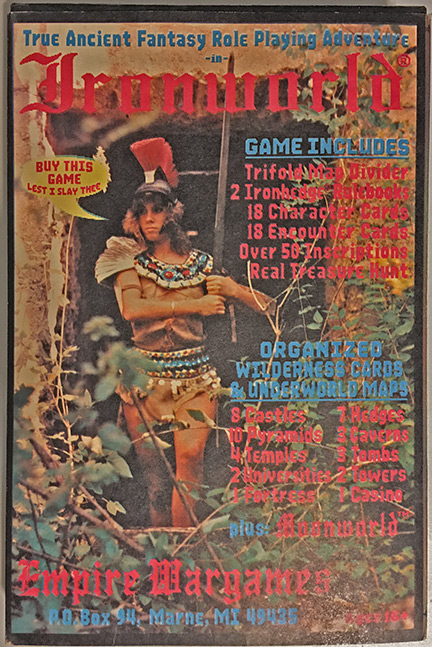


4. LegendQuest (by John G. Josten; published by Board Enterprises in 1991)

The clean but small Times Roman type makes this look a little bland, but it is a welcome change from newer games that try to get fancy, hurting legibility in the process. I too may be guilty of this on occasion. Anyway, The introduction touches on die rolls, which is basically multiplying the attribute related to the relevant skill by 10, multiplying the skill rating by 5, and totaling those values for a chance of success on a percentage roll. Unskilled rolls get penalized by -15. Resisted rolls see the chance of success reduced by five times the resisted attribute. Pretty easy. There are other types of rolls, like assisted ones. Next, onto characters, which consist of six attributes on a scale starting at 1 and going up to a maximum determined by the chosen race (looks like around 5 to 14, though costs seem to get too expensive at the higher levels). The attributes are Strength, Knowledge, Endurance, Willpower, Agility, and Psyche. Skills are rated from 1 to 7. There are five player races: Humans, Elves, Dwarves, Ogres, and Halflings. Combat starts on page 23. It's all pretty straightforward with lots of good tactical options. Page 36 sets up the magic content, with spells being defined with useful information, like casting times, materials needed, accuracy, casting fatigue, etc. After the rules and a fair number of spells, the mentalism chapter begins on page 60. This is basically more spells, but related to mental powers. Equipment begins on page 64, followed by creatures on page 74. Finally, a gamemaster section begins on page 94, with lots of references pages and then a number of sample characters on sheets. This appears to be a solid percentage-based fantasy game, though it may be lacking in setting material. Art is sparse and basic, but doesn't harm the experience. It seems a bit more complicated than it needs to be. A good editing pass could probably cut the rules in half -- not that there are a lot of rules or discussion of them. All in all, a respectable product. And guess what? You can get it in PDF format, although there are different versions of it, so here is a link to all the publisher's titles.


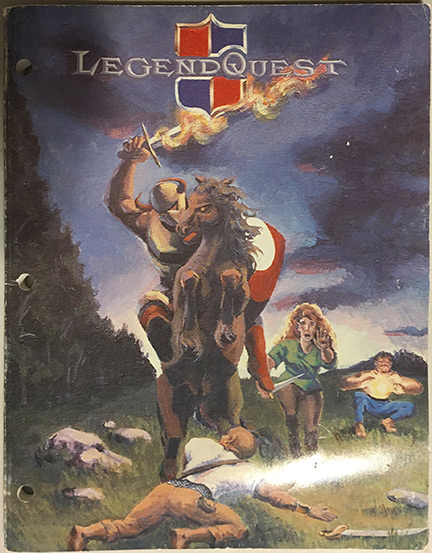


5. Fantasy Imperium (by Mark O'Bannon; published by Shadowstar Games, Inc. in 2006)

This a is thick hardcover, but from flipping through the pages, it seems to be due to lots of spell and equipment tables, so probably not as intimidating as my first glance. Just by going on the introduction, these aspects stand out as themes of the game: storytelling, forbidden magic, spiritual warfare, fate, luck, piety, and spirit. Let us see. Chapter 1 begins with the basics of characters. There are ten characteristics, seemingly rated from 1 to 100, since d100 rolls are made: Strength, Endurance, Dexterity, Intuition, Self Discipline, Reasoning, Ego, Awareness, Presence, and Attractiveness. That's a mouthful. Female characters get adjustments to their characteristics, so their Strength is less, but their Dexterity is slightly more. Skill rolls are percentage-based with the odds being equal to one fifth of the relevant characteristic, and each skill level adding 10. Proceeding to the next few chapters (Combat, Movement, Injuries & Death, Morale & Healing, and Fighting Styles & Tactics), we find out that it is all pretty methodical, following the same pattern of modified percentages. Chapters 8 through 13 discuss various forms of magic, spells, and so on. Chapters 14 through 16 are all about equipment, weapons, armor, and the like. These take up more room than they need due to the tables used. Chapter 17 describes mystical races, such as halflings. Pages 244 to 417 are all appendices, including weapon and armor illustrations, and 17 pages of historical setting detail. Some of the art is really nice, but others are simple line art. I don't get this game. It's just huge. And while the system is fairly simple, there are so many options and details that it could even discourage readers with better attention spans than myself to get through the whole book. This game is not my cup of tea. That said, I'm sure there are lots of people that would appreciate it. I see that a quickstart is available for this, but I'm not sure about the full product. Here's the publisher's web site.


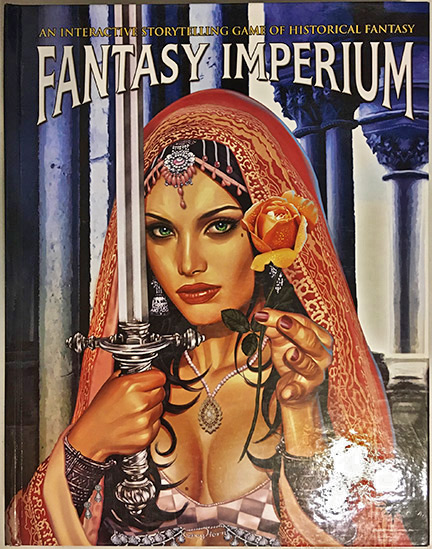


6. Sun and Storm (by David B. Pilurs; published by Storm Press in 1992)

There are two short books in this series, the Enchiridion (player's guide) and the Codex (GM's guide). The game is billed as dark fantasy in which you "take the role of a gritty stoic hero driven to survive in the face of overwhelming odds and a ruthless, relentless foe." We venture forward. Introductions are as expected, and we need one ten-sided die. We are then presented with a tale of universal creation, stormwyrms (dragons with wings of lightning) that rule the stormsea, technomancy, and other themes. It's odd, but I can see it working if you can immerse the players into the setting enough. There are four races. I won't go into them, because they have unique names and talents. Let's just say that you can probably pick out the dwarves and elves. There are ten attributes, rated from 1 to 12 or more: Stamina, Strength, Agility, Speed, Willpower, Perception, Creativity, Charisma, Power, and Technology. There are also six pools, which are things like resistances, improvement points, and luck points (though defined by other names). Finally, skills, special abilities (mostly magical powers), and random tables for appearance, family, friends, and so on close out character creation. Equipment and a sample character come next, followed by the actual rules. Basic task rolls involve adding 1d10 to the attribute or skill rating and any modifiers. If the total is greater than the difficulty (usually 10, 15, or 20), then the tasks succeeds. What may throw some people off is that the total rolled is called the Task Strength, which is very easy to confuse with someone's actual Strength attribute. Note that base skill ratings are equal to the sum of two relevant attributes. If you lack the skill, the highest of the two needed attributes is used for the roll. Combat and magic work the same way, with defenders adding modifiers to the difficulty. I obviously oversimplified it, but you hopefully get the point. It's not that complicated, but you need to understand how to modify rolls. The first book is 96 pages in length. Let us see what the second book has in store for us...

The second book starts out with advice for the GM, who is called the Divine Presence in this game. There's some good information here. Of note is the expanded difficulty table that really helps describe which values work best for various circumstances. Next is information on creating your own setting. I was under the impression that this had a defined setting, but perhaps that was just for the background, allowing you to do with it as you please. We're on Chapter 4 and it's all about the land of the living and the dead. This is a very short discussion on some of the types of beings. Another short chapter is all about villains and personalities, followed by how to create mounts and monsters. The next few chapters are about movement, enchanted items, and hero improvement. Finally, we get a sample adventure, which seems to hold the GM's hand and is short, so that's a good thing. The rest of the book consists of sample villains and monsters on full-page sheets and then reference pages.

This game baffles me. I think I see what they intended, but it does not hit the mark for me. When I hear dark fantasy, I think about a setting similar to that of Darkurthe Legends (see Part 6). I also expected this to be more setting-specific given the tone and special races. It's more generic though, which throws me off a bit. I mean, it sort of has setting elements that are quite alien. I just don't know.





What mysterious games will be in part 13? I'm not sure, but I bet they will be interesting. In the meantime, here's some new products to pimp. Fans of the sword and planet fantasy genre should check out Planets of Peril. If you'd like to use cards instead of dice, check out The Amazing 20in1 Card Deck, perfect for when you can't roll dice, such as in the car. And for real vintage goodness, there's the Wee Warriors line of Original Edition Fantasy supplements. Better yet, just check out Precis Intermedia's Vintage Collection, consisting of classic reprints.


Part 13... | | 0 Comments | Add Comment | Permanent Link | See All Posts Tagged as "ForgottenGames" | | Read more... | |
This is part 13 in a series discussing forgotten RPGs (also see Part 1, Part 2, Part 3, Part 4, Part 5, Part 6, Part 7, Part 8, Part 9, Part 10, Part 11, and Part 12). That is, games most people have never heard of or that didn't last long on store shelves for one reason or another. This entry consists of mostly fantasy titles.


1. The MEGA Role-Playing System (by Isy Allon and Ben Brakas; published by MEGA Games Ltd in 1987)

This hardcover is printed on glossy paper, with an extremely legible but bland layout. The introduction devotes two paragraphs to explaining the manufacturer's publication codes. I think they only released this book and an adventure, so yeah. Anyway, we're hit with the basics of dice, measurement, open ended rolls, play aids... and also "s"-dice. This dice notation represents an extra die rolled with the base die. According to the example, s24 means to roll 2d10 + 1d4, and s47 indicates rolling 4d10 + 1d7. It's a little confusing. There is a gamemaster's code with 15 bullet points, as well as a player's code with 5, all fitting for a fair and potentially exciting game. Unlike most games, the Attributes (Strength, Health, Endurance, Coordination, Manual Dexterity, Handedness, Learning, Willpower, Awareness, Artistic Creativity, and Musicality) have potential ratings, which indicate the maximum value the character can have in an Attribute. The current rating depends on the character's level of development. The potential can be determined randomly or via point allocation. Sample random potentials are given, but this gets a little complicated, because you need to figure out how many dice to roll for a given value according to the aforementioned dice conventions. I don't like it. Before I go on, I want to point out that there are large tables for determining point allocation and current values. There are also calculated values, including size and weight. Regular training is required to maintain attributes and skills. The base mechanic is attribute + 2d10, where rolling over a difficulty number is successful. Skills also have potential values, but this is based on their related attributes. Skill rolls are essentially attribute rolls plus a skill bonus and either 1d20, 2d10, or 3d6 (depending on the coverage/length of the action). A number of backgrounds are provided with potential attribute and skill values. Damage is covered next, using a chart to compare the damage value vs. the target's size. The final value translates to a dice roll (which you need to figure out how to handle). Armor reduces the damage value before determining the dice roll. Basic attacks are rolled with a d20 plus attacker's value beating the defender's value. There's a number of adjustments and special rules. Again, there are lots of tables, but they are very legible and organized well. Other sections, like movement, poisons, magic, and creatures are also mostly organized well. One really nice touch for each creature is the highlighting of their habitats on a line-drawn map of the earth. Is this game for me? Not really. It doesn't seem particularly complicated other than the potentials, but nothing really resonates with me. Having to use your own judgement in determining which combinations of dice to roll is rather offputting. I never heard of this game back in the day; given that it is from the UK, it's possible it didn't make much of a splash in the US.





2. Knights of the Round Table (by Phil Edgren; published by Little Solder Games in 1976)

We start with a short preface on the world of the Round Table and then a brief introduction. Most significantly discussed is that the game requires 25mm miniatures, or any other scale as long as you make adjustments. Sheets of cards are also included (two identical sets, one for each player), but you will need percentage dice. Also of note is that the game's scope can either be a single combat, tournament, or campaign. The first chapter begins with combat. Eight of the cards represent attacks, showing the percentage needed based on the opponent's chosen card. The better the result, the more potential effects are inflicted, such as stun, wound, unconscious, dead, and fall. Pretty easy. Apparently, each character has a prowess rating. The difference between the two character's prowess can be spent to increase die rolls or strike first (for the higher one). Prowess is utilized for other rules too, such as using only one hand for a two-handed weapon. Wounds decrease prowess. Other bonuses and penalties can also be applied. Other rules include grappling, jousting, feuds, and a number of options. Chapter 2 discusses "The Tournament," which is essentially combat involving more than two charactes. There are optional rules for that too. Chapter 3 is about Chivalry, which is all of three pages. Then we hit Chapter 4 for limited campaigns. This consists of creating characters (they basically only have a prowess rating), travel, encounters, healing, love, remorse, and GM ideas. Chapter 5 brings us to the full campaign, which discusses broader topics like warfare, domains, magical power, and miscellaneous notes. That's about it. It actually looks like a fun little game, albeit extremely limited. House rules would probably be needed for a better experience.

Shill alert: The long-lost Sir Pellinore's Game is back with a series of reprints. It is of the same era (for both release date and subject matter), but covers more bases for the rules in as simple a way as possible.





3. Perilous Journeys (by Jamie Hardy; self-published in 2010)

A bit more modern this time, our first encounter is a list of terminology over one and quarter pages. Then we hit character creation, so I would say that this is not for people new to roleplaying, but I suspect the system is quite easy to learn. An overview of the character creation process is followed by specifics for each race, discussing the allocation of points to core attributes, selecting edges and flaws, etc. The core attributes are Health, Agility, Mind, and Speed. These are percentage-based, with each race having minimums and maximums for a given attribute. Races include Humans, Dryads (tree nymphs), Dwarves, Elves, Fomorians (semi-giants), Gnomes, Lurikeen (fairies/leprechauns), and Wild Elves. Racial traits are also applied, which act like special abilities. You then choose 5 abilities, with one being weapons. The text seems to treat abilities and skills as the same thing. It's a little confusing. Edges and flaws can also be chosen. There's also a mana pool for some things, I suppose for spells mainly. Strength is designated as an optional attribute, and Endurance and special moves are applicable if advanced combat is used. You can also choose a profession via guilds, which further enhances the character, but I'm getting really confused at this point. I think this whole process could have been handled a lot simpler, perhaps with better organization. The next section talks about spells. There are different types of magic, each with different spells: Dimensionology, Elementalism, Enchantment, Necromancy, Shamanism, Sorcery, and Theurgy. Page 89 begins discussion of the game system, which primarily consists of percentage rolls. Roll equal to or under your attribute or ability to succeed. Percentage modifiers can also be applied to a roll. Fate points can optionally be used to modify rolls. Combat works similarly, with damage being equal to weapon damage less armor factor. Armor can be degraded and repaired, which is a nice touch. The advanced combat rules add more special abilities that can be learned, such as block, cleave, and magic fist. Towards the end, we hit topics on creating and modifying professions, magic items, monsters list, weapons tables, and finally some character sheets. All in all, this seems like a serviceable game. I'm not sure if it introduces anything new, but you can decide that for yourself, since it is available as a free download.





4. Real Wonders & Tremendous Gambits (Book 1) (by Roby Ward and Timothy Guiosky; self-published in 1987)

This one comes in a spiral binder. A bit unusual, but you can lay it flat or even stand it up, which is convenient. Is the rest so accommodating? Let us see. This is apparently Book 1 of 5, as well as the second printing. I have no idea if the other books were ever published. This one covers the rules, whereas the others in the series were for Medieval Society, Developed Society, Metaphysics, and Beings & Beasts. We are met with the typical introduction, although it should be noted that the game is not of pagan or satanic origins, as both creators are fine Christians, or so they claim :). They do not use the deities of any real-world mythos as to not offend anyone. That's part of the disclaimer. Characters use 7 attributes with values equal to 2d20 and a minimum of 6: Muscle, Constitution, Endurance, Involvement, Coordination, Charisma, and Willpower. Secondary attributes include Consciousness, Dexterity, Fatigue, Hit Points, Intelligence, and Social Standing. Not sure how I feel about Intelligence being a secondary attribute, and Involvement is essentially reflexes and reaction, but Dexterity is secondary. Seems a bit odd, but not a deal-breaker. Next, we are presented by some random tables for racial type, hair and eye color, general height, and homelife. Skills are next, with a discussion of using points to purchase them. A nice filled-out character sheet follows as a sample character, but it is still unknown (at least to me) as to how to calculate the related skill values (SMP TASKS, DIFF TASKS, etc). Here we go. The next section is all about the action. The use of specific attributes in mechanical terms are presented here. For example, Muscle is used to lift objects. If you try to lift more than the standard weight for a given rating, you must make a roll against the Muscle score. However, I have no idea how to roll at this point in the book, unless I missed it. Moving on, we learn that tasks have different difficulties, based on the level. If I understand this correctly, mulitply the skill level by the difficulty's factor for a base percentage. Then a bonus is applied if the skill level is at least equal to the difficulty range, doubled if greater than the difficulty range. Not too complicated, but I did have to read it a few times. One thing I noticed is that there is a lot of discussion in this book, but not enough focus on the basic mechanics, rather their abstract functions. After this, we get skill descriptions, which is followed by "The Rules," which seems an odd choice. Perhaps, this should have been titled "Combat." Rounds consist of impulses, during which the character can act, similar to how Champions did it. This goes on for about 5 pages. Using different types of weapons is discussed. There is a formula to determine the minimum Coordination needed for weapons, as well as a formula for damage. Maximum range uses simple formulas. There's lots of rules here, like rolling multiples of 10 causes a critical hit or fumble. Aimed attacks, parrying, sweeping, and other possibilities during combat are covered. Character Advancement utilizes XP and levels to allow for the increase in attributes and skills. Finally, there's some GM notes, example of play, and bunch of tables in the back. I think this game could have benefited from a short primer. The rules do not seem complicated, but the writing hampers my comprehension. Just an explanation of the mechanics in a sidebar or single page for reference would have greatly helped in my opinion. This would have been a pass back in the day.





5. High Fantasy (by Jeffrey C. Dillow; published by Fantasy Productions, Inc. in 1978)

1978 seemed to be a popular year for new RPGs, as it also saw What Price Glory and Sir Pellinore's Book, among others. The layout is basic, but that means that everything is easy to read. The first thing we need to know is that the game uses percentile dice. Creating characters starts at page 5, with 11 steps summarized. There are four main classes: warriors, wizards, animal masters, and alchemists (each listing which steps are relevant; a nice touch). The first problem facing those new to this game is that the offensive and defensive probabilities for the character are nowhere to be found. We are told to see Table 1. After flipping through the whole book, Table 1 is on page 32, but we can now look up these values for level 1 characters. The next step is to roll for innate abilities, adding a modifier from that table. A roll is made on tables to determine how many spells wizards get, as well as strength, coordination, and quickness values. Finally, we determine the number of starting tams (currency), purchase equipment, and determine encumbrance. After all this is done, a player may also choose a subclass for his character, with specialized abilities. On to combat, which is composed of two segments. One segment is for movement, missiles, and magic, while the other is for melee. Characters act in order of highest quickness, with attack rolls being pretty simple in the form of attacker's offensive probability reduced by the defender's defensive probability. If successful, the combat table is consulted. The column is shifted left or right, depending on the weapon modifier, and another roll is made, comparing it to the original probability. Damage gets a little confusing. There are three numbers involved here. The one one the left is subtracted from the defender's offensive value. The top-right number is subtracted from the defender's defensive value, and the bottom-right number is subtracted as armor damage. Critical hits and stun may also be applied. Magic requires mana to be spent, with spells being more potent as characters increase in level. Creatures and some notes round out the rest of this 48-page book. It's a fairly simple system with good coverage of basic fantasy elements, with a bit extra thanks to the subclasses. I like it. Note that there was also a second edition by a different publisher with a more professional layout and adventure books.





6. Mage (by Wilf K. Backhaus; published by Archaeron Games Ltd in 1980)

We jump right into character generation. The first step is social class, with different odds of achieving Noble, Middle, or Rabble as random choices from each of 5 races (human, elf, dwarf, halfling, and goblin). Next up is body type of which there are three (Ecto, Meso, and Endo) with different random odds for the various national groups. Size is similar with different odds for Small, Average, and Tall, depending on body type and whether male or female. Primary characteristics are classified as either physical (Strength, Agility, Dexterity, and Stamina) or psychological (Mental Approach, Deadliness, Social Attitude, Piety, Sensitivity, and Greed), and rated from 2 to 10. That's an interesting mix. The ratings are determined by rolling a d6 and adding a modifier based on size and body type. Basic rolling for stuff not covered in the game, like raw characteristic use, is with 1d10, with success achieved by getting a result equal to or less than the rating. We move onto Attributes, which are calculated values, including Endurance, Coordination, Shock Resistance, Behavior Pattern, Visionary Capacity, Psychic Capacity, and Demonic Control. A roll is also made for Education level and age. Now comes the meat of the system: Magic. There are various types of magic-users, from psychics to necromancers, with certain requirements and special rules for each. Mages also have a Magic Potential and Magic Level. There are rules for raising level and learning new spells, as well as personal magic devices. Using magic requires a d20 roll under the Basic Magic Attack rating, which is modified by various factors, including strain for a bonus. A save can also be made to resist spells by psychic talents and ordinary magic users. The various spells are explained next, followed by a few pages on characters (these are non-player characters and animals, as player characters are called Personae). Wounds are finally touched on, which lowers the endurance by a certain amount, depending on the severity (light to mortal). The last page lists the credits and some final words. While there is very little outside of rules in this book, I think it accomplishes what the author set out to do. It seems very playable and quick once you have all the attribute calculations done. As part of the Archaeron Games System, this is a companion book to Warrior from the same publisher.





This is not the end. I've got some more entries for another list. And if you want to check out another forgotten game, try Submachine Gun, the WWII RPG from 1981, available once again. | | 0 Comments | Add Comment | Permanent Link | See All Posts Tagged as "ForgottenGames" | | Read more... |
|
|
|
|















































































